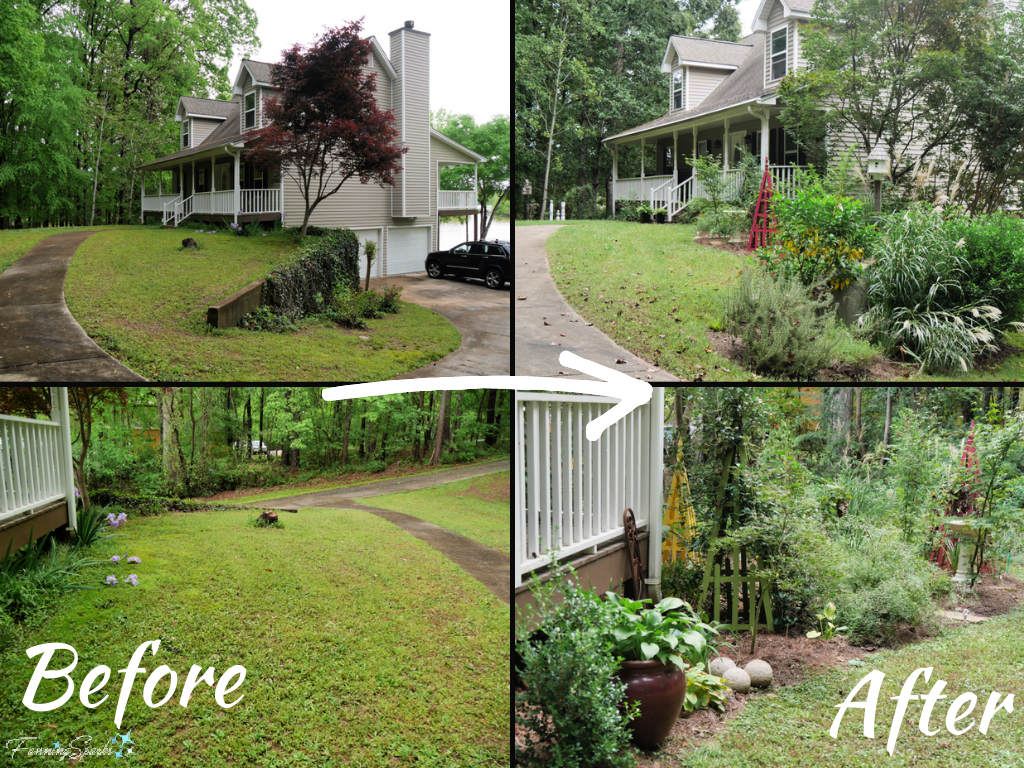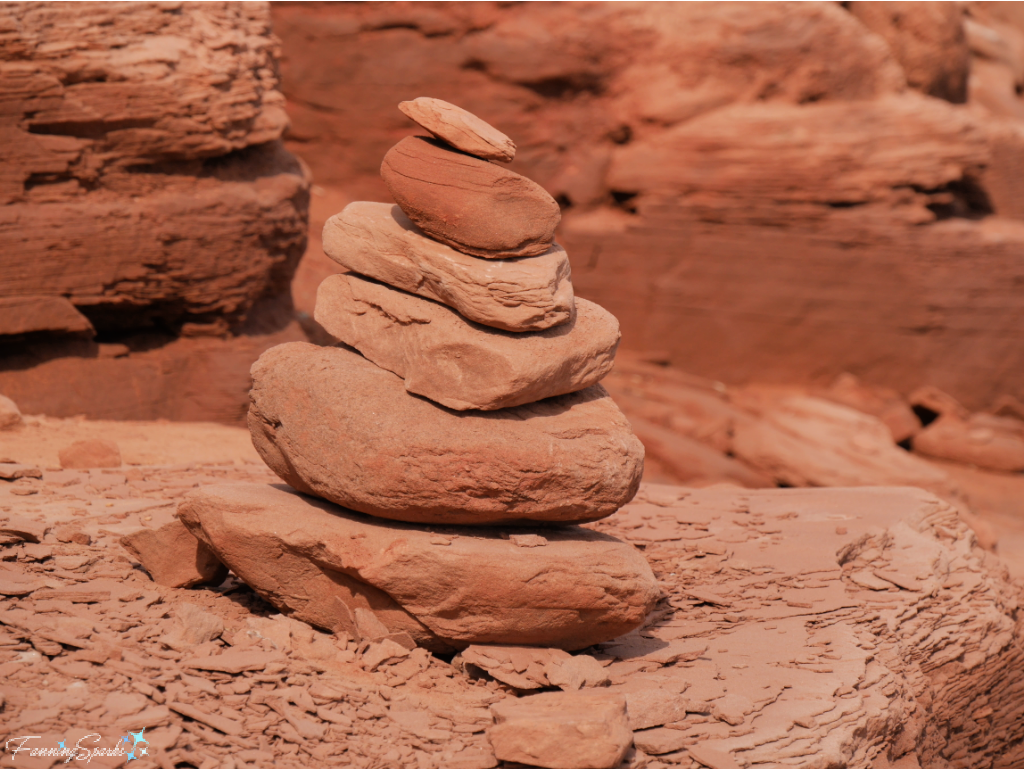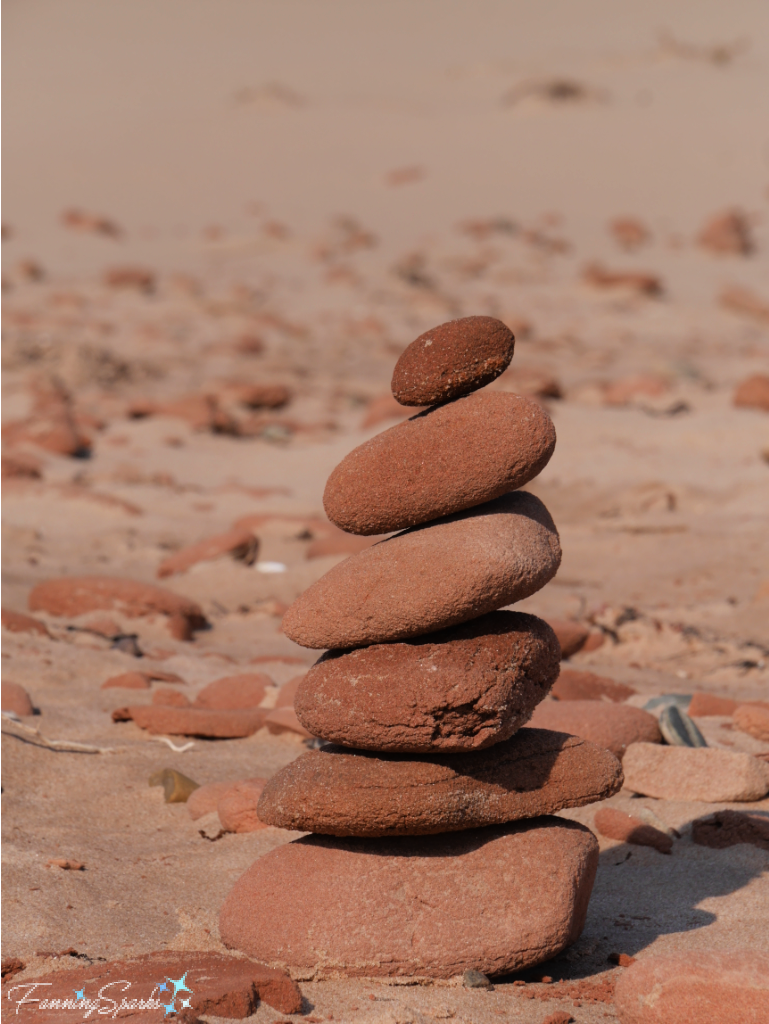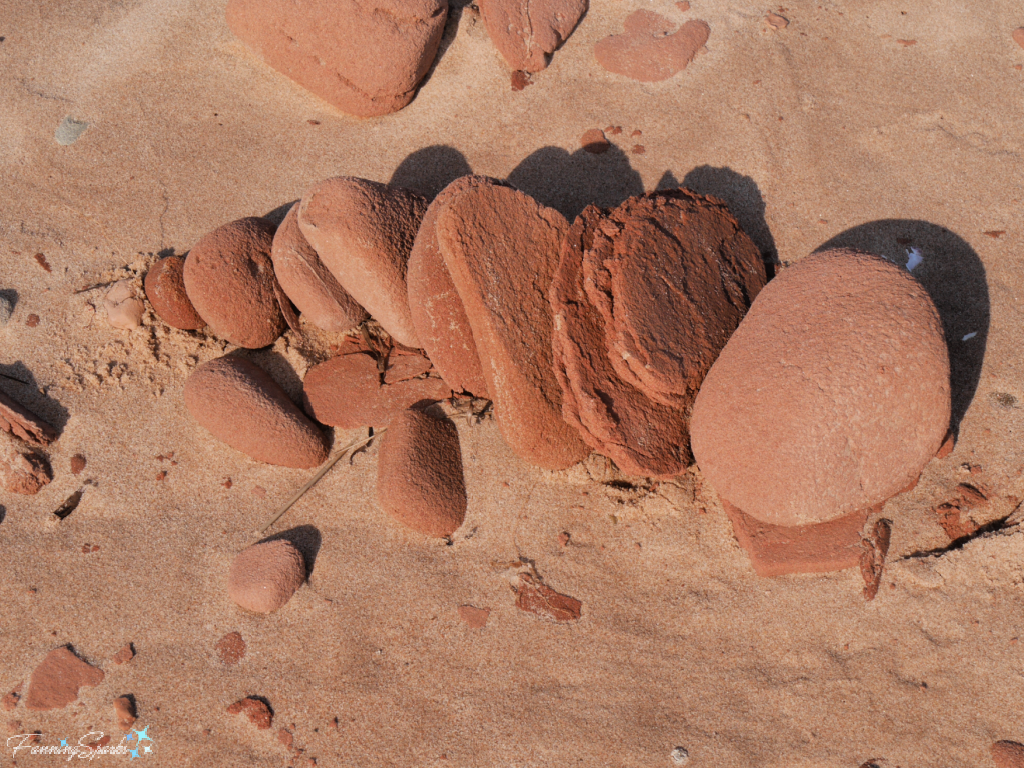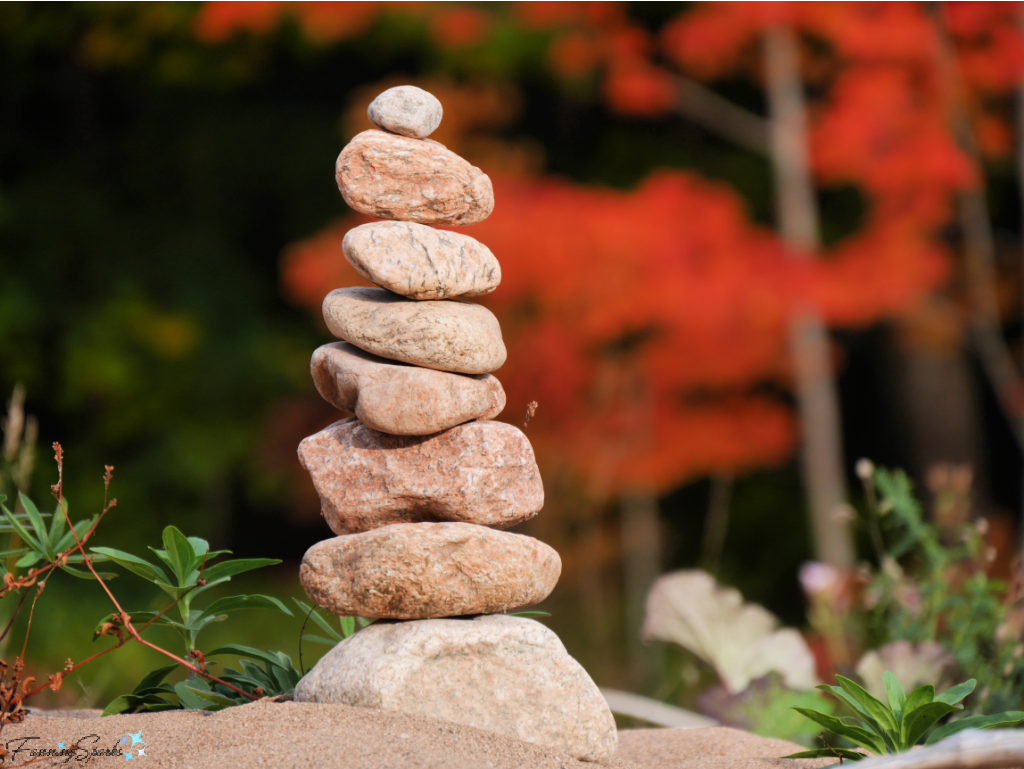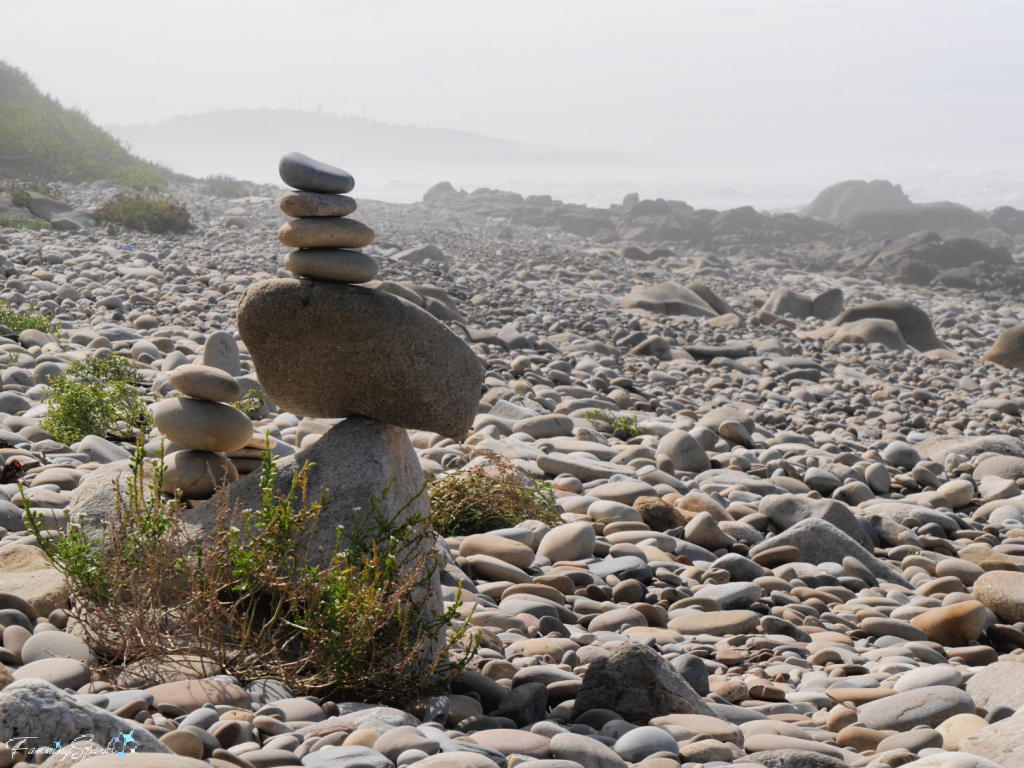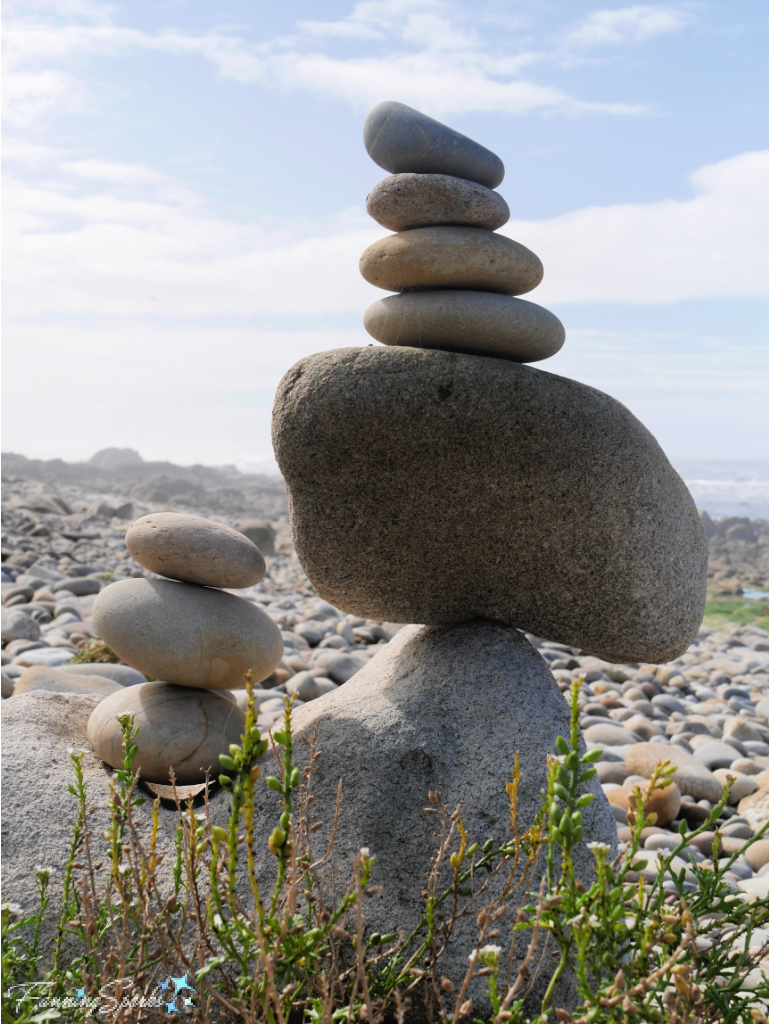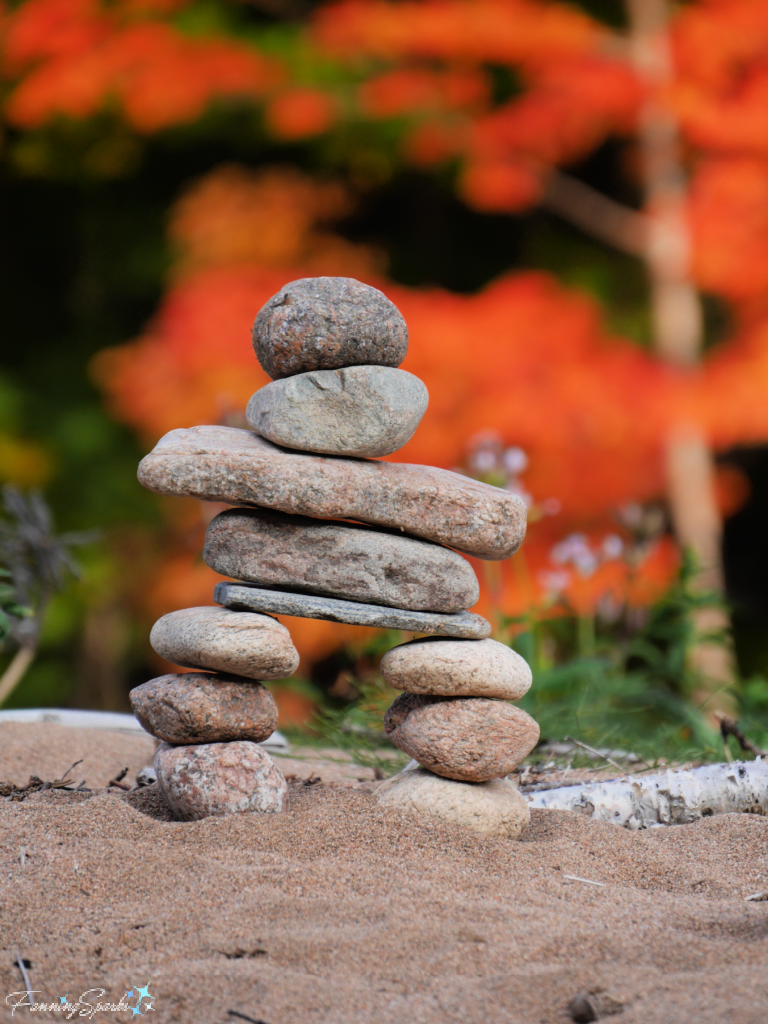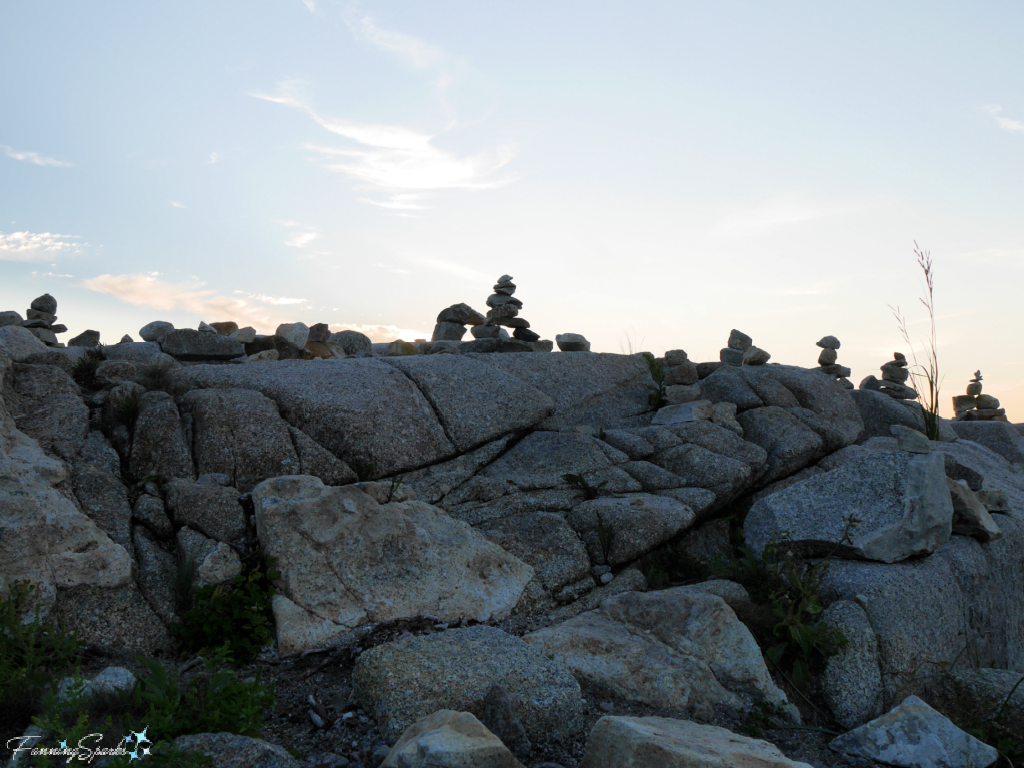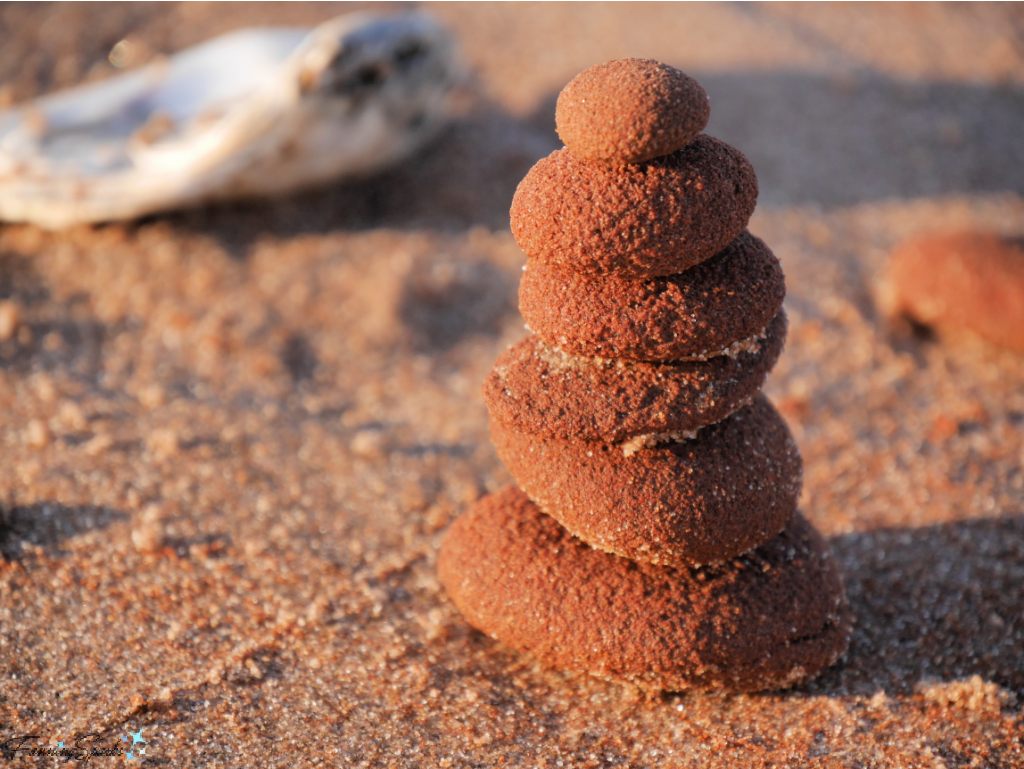Decorating for the holidays gives us a chance to bring cherished treasures out of storage and enjoy them in our homes. It’s also a great opportunity to get creative and make something new. Adding one or two new items into the mix keeps things interesting. This year, I decided to try something a little unexpected—stitching wood! I love the warm and cozy feeling of natural wood. Highlighted with the red and green of the season, it’s perfect for the holidays. I dusted off my geometry skills and designed a decorative dodecahedron. The 12-sided sphere is made of wooden pentagons stitched together with pearl cotton thread. Each pentagon shape is embellished with a bright and cheery red star. Here’s how my Starry Stitched Sphere turned out!
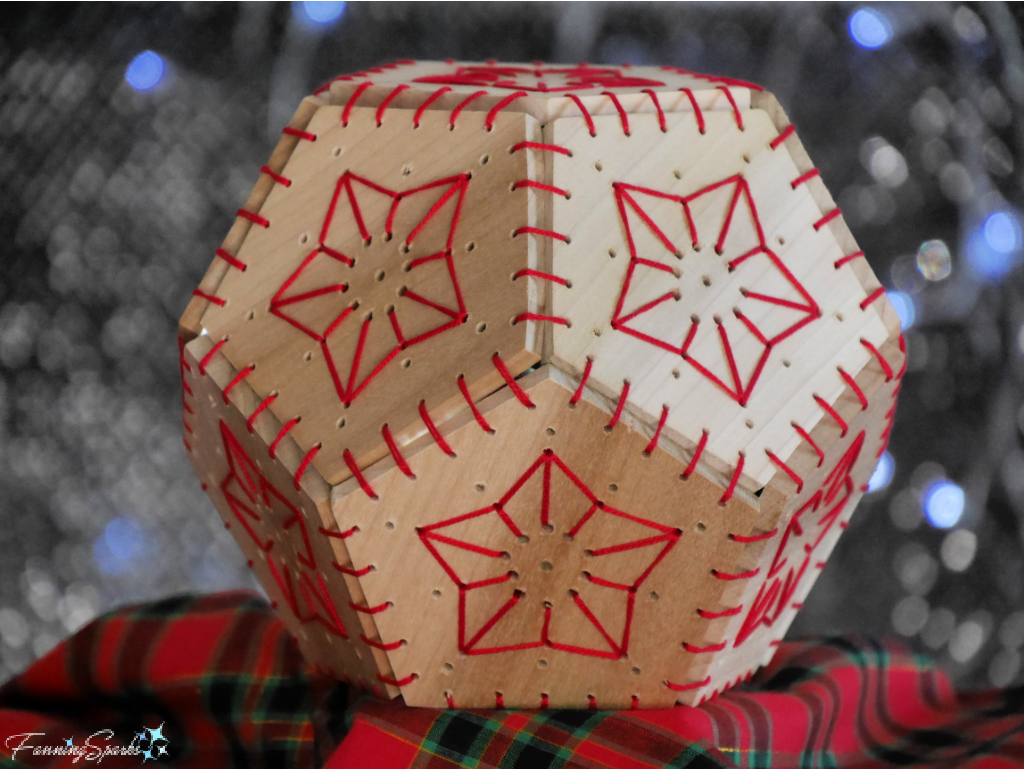 In today’s post, I’d like to share step-by-step instructions so you can make your own Starry Stitched Sphere. This project requires only a few supplies—basically wood and thread. The sphere is designed to be made from ¼” x 3½” wood and measures just over 6″ in diameter. Basic woodworking and hand stitching is involved.
In today’s post, I’d like to share step-by-step instructions so you can make your own Starry Stitched Sphere. This project requires only a few supplies—basically wood and thread. The sphere is designed to be made from ¼” x 3½” wood and measures just over 6″ in diameter. Basic woodworking and hand stitching is involved.
Supplies Needed
The pictured supplies, described below, are needed to make this project.
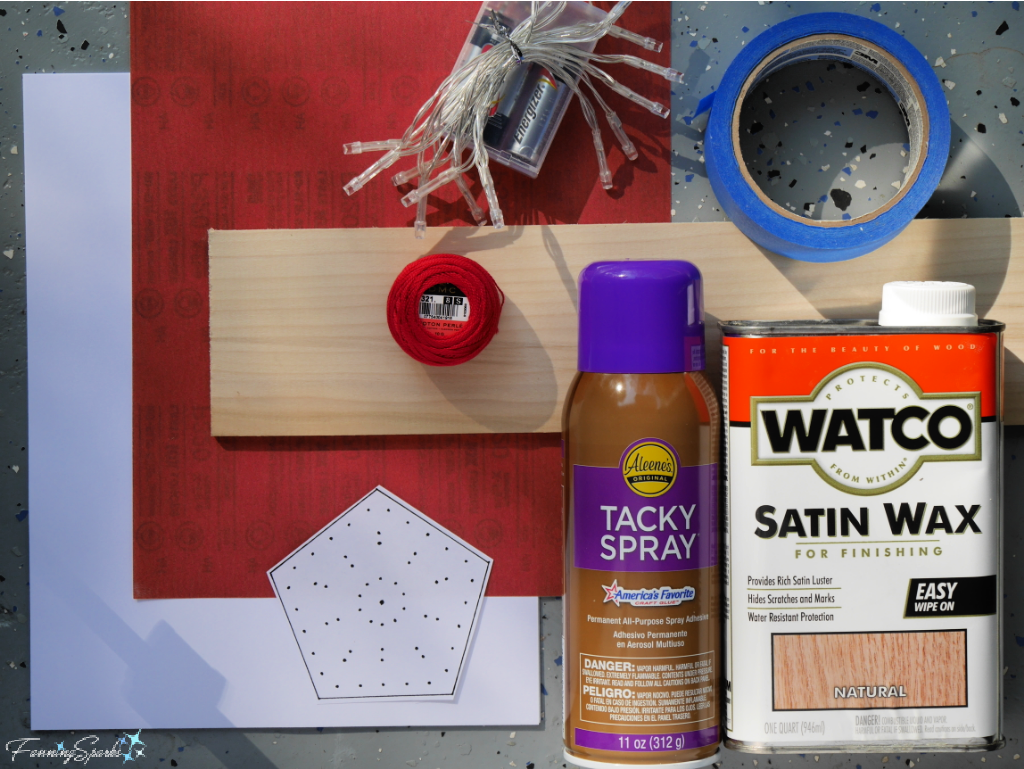
.Template: Download Starry Stitched Sphere Pentagon Template – Complimentary Download to print the template for the pentagons.
. Paper: A few sheets of white paper for printing template.
. Wood Board: ¼“ x 3½” x 4 feet in light wood such as pine or poplar.
. Painter’s Tape
. Spray Adhesive: I used Aleene’s Tacky Spray.
. Sandpaper: In fine grit.
. Finishing Wax: I used WATCO Satin Wax for Finishing in Natural color. Alternatively, you could choose to stain the wood or leave it unfinished.
. Thread for Assembly: About 18 yards of DMC Perle Cotton. I used red in size 8.
. Thread for Star Embellishments: About 25 yards of DMC Perle Cotton. I used the same thread for assembly and embellishment–red in size 8.
There are a number of options for the star embellishments. They can be stitched in the same thread as that used to connect the pentagons. Or the stars can be stitched with a decorative thread such as metallic embroidery floss. The stars can be stitched as 5 straight spokes, fully filled in, or something in between. Here are some options to consider.
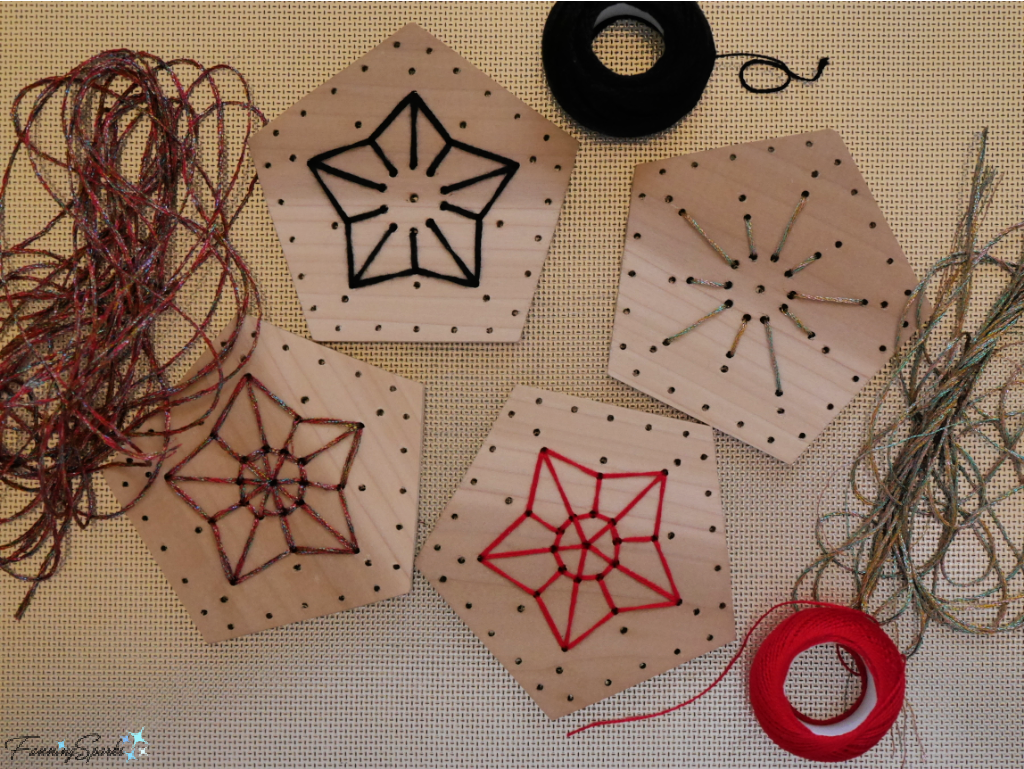 . LED Lights (optional): Battery-operated LED lights can easily be inserted into the Starry Stitched Sphere. If you decide to add lights, you’ll want to maximize the amount of light that can shine through the drilled holes. You may want to drill bigger holes and/or minimize the amount of stitching on the stars.
. LED Lights (optional): Battery-operated LED lights can easily be inserted into the Starry Stitched Sphere. If you decide to add lights, you’ll want to maximize the amount of light that can shine through the drilled holes. You may want to drill bigger holes and/or minimize the amount of stitching on the stars.
Tools and Equipment Needed
. Printer: To print template.
. Scissors
. Tape Measure or Ruler
. Jigsaw
. Clamps
. Drill with 3 bits including 7/64”, 5/64” and 3/32”.
. Tapered Round File: To sand the drilled holes. I used a diamond- and titanium-coated steel file designed for jewelry-making.
. Rags: Lint-free rags such as an old t-shirt.
. Gloves
. Needle: A dull-pointed tapestry needle is ideal.
Step-by-Step Instructions
Step 1. Print Patterns Download the Starry Stitched Sphere Pentagon Template – Complimentary Download and print the template for the pentagons. Take care to ensure the scale is accurate on your printed version. See specifics in the download document. Print 11 copies. Trim patterns with scissors.
Step 2. Adhere Patterns Cover wood board with painter’s tape. This tape makes it easier to remove the patterns from the wood.

Spray back of one paper pattern with adhesive. Position carefully on board (on top of painters tape) aligning bottom of pentagon with bottom edge of board. Smooth and press down. Repeat for remaining 10 pentagons. Arrange as shown to minimize cuts and reduce scrap.
Note: You may notice the pattern shown differs slightly from the version provided in the download. The download is a more accurate version.
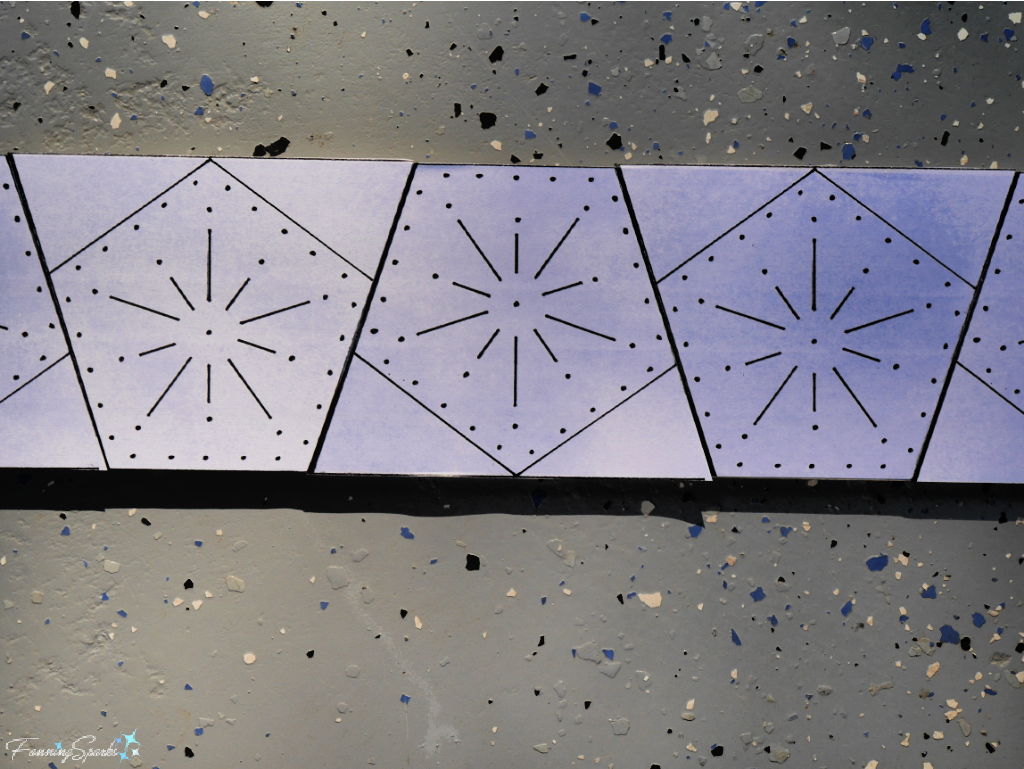 Step 3. Saw Wood Pentagons Clamp wood to sturdy surface. Use the jigsaw to cut out 11 pentagon-shaped pieces.
Step 3. Saw Wood Pentagons Clamp wood to sturdy surface. Use the jigsaw to cut out 11 pentagon-shaped pieces.
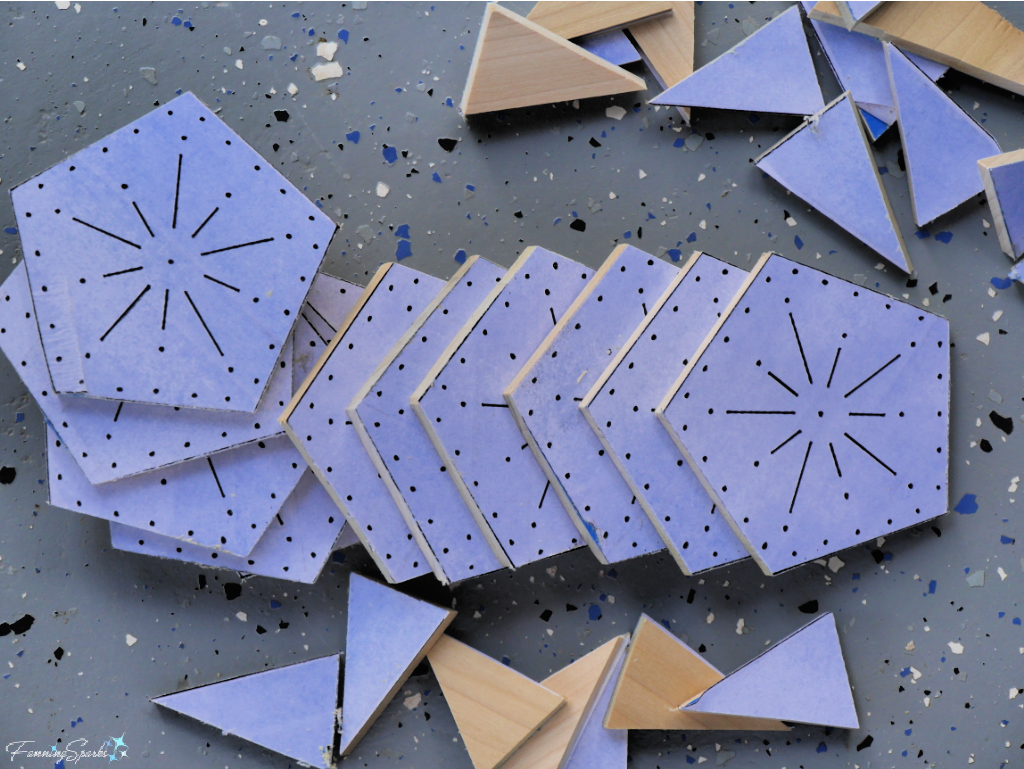 Step 4. Drill Wood Pentagons Clamp a pentagon on top of scrap wood to prevent tear out at back. Drill all outer edge holes with a 5/64” drill bit. Drill center hole and inside ring with 7/64” drill bit. Drill all other holes with 3/32” drill bit. Repeat for remaining 10 pentagons.
Step 4. Drill Wood Pentagons Clamp a pentagon on top of scrap wood to prevent tear out at back. Drill all outer edge holes with a 5/64” drill bit. Drill center hole and inside ring with 7/64” drill bit. Drill all other holes with 3/32” drill bit. Repeat for remaining 10 pentagons.
 Step 5. Sand Wood Pentagons Sand edges and drilled holes. This is an important step since any roughness, especially along the edges of the holes, will snag the thread during stitching. A round tapered file is critical for this step.
Step 5. Sand Wood Pentagons Sand edges and drilled holes. This is an important step since any roughness, especially along the edges of the holes, will snag the thread during stitching. A round tapered file is critical for this step.
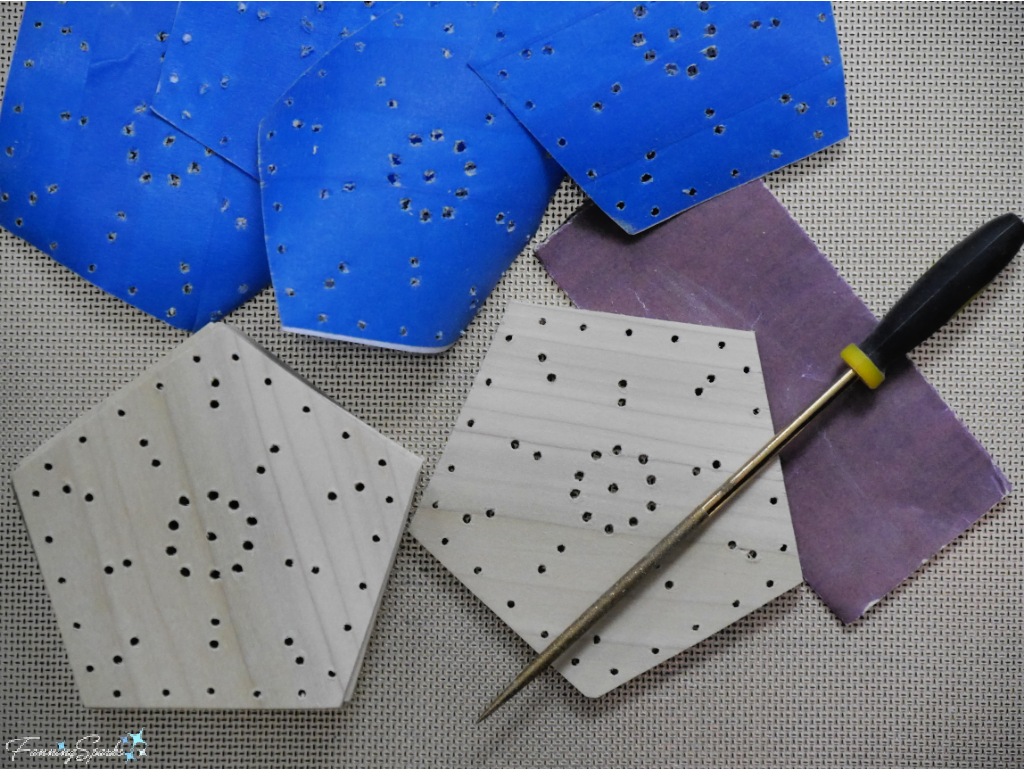 Step 6. Finish Pentagons Follow the manufacturer’s instructions for applying the wax. I used Watco Satin Wax for Finishing in Natural. Apply a generous coating to the front and edges of the pentagons. Let it soak in for about 15 minutes and reapply to any areas that dry out. Then wipe off the excess with lint-free rags. Buff and let dry.
Step 6. Finish Pentagons Follow the manufacturer’s instructions for applying the wax. I used Watco Satin Wax for Finishing in Natural. Apply a generous coating to the front and edges of the pentagons. Let it soak in for about 15 minutes and reapply to any areas that dry out. Then wipe off the excess with lint-free rags. Buff and let dry.
Please note: this product has a very strong odor so be sure to use it in a well ventilated area and allow plenty of time for the wax to dry and the smell to dissipate. I waited 4 days.
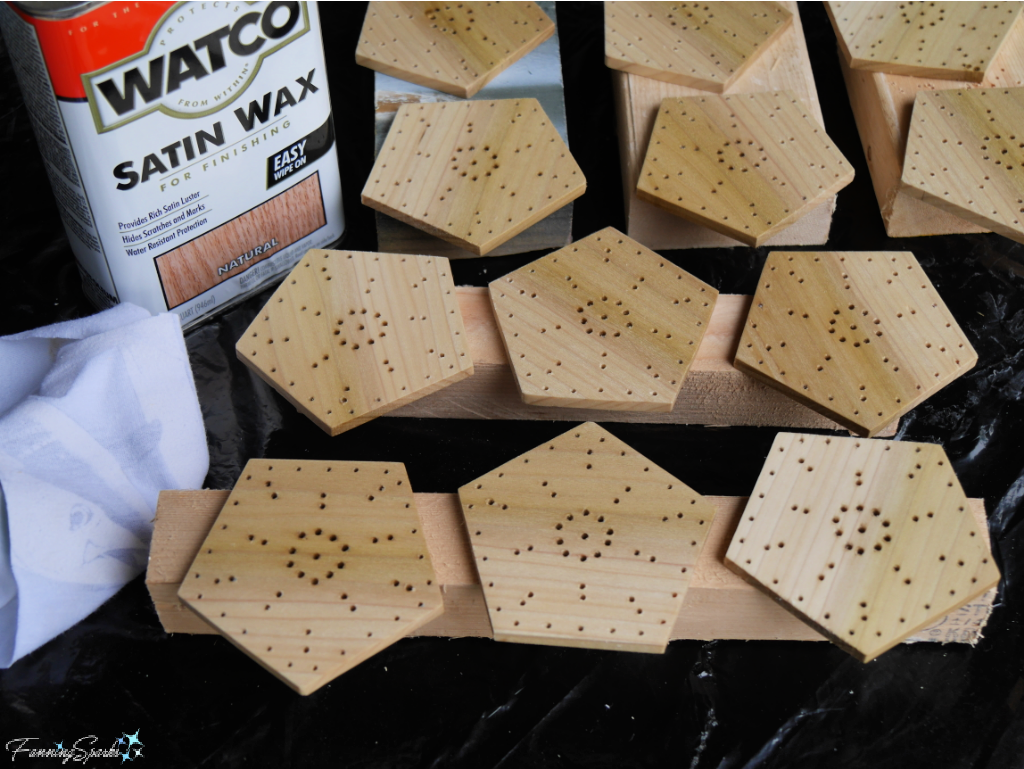 Step 7. Embroider Stars As noted in the Supplies Needed section above, there are a number of options for the star embellishments. You may wish to try stitching a few different configurations after your wooden pentagons are dried.
Step 7. Embroider Stars As noted in the Supplies Needed section above, there are a number of options for the star embellishments. You may wish to try stitching a few different configurations after your wooden pentagons are dried.
The design shown requires about 72” of pearl cotton thread for each star. The stars are stitched with a double thread so pull thread ends even and knot. Begin at the back of a wooden pentagon leaving a 1 ½ -2 ½ ” tail. Simply lace needle in and out of holes to stitch around the star. Knot tails at back to secure. The back will not show so there’s no need to worry about how it looks. Repeat on the remaining 10 pentagons.
 Step 8. Assemble Ring of Pentagons Start by connecting a row of 5 pentagons.
Step 8. Assemble Ring of Pentagons Start by connecting a row of 5 pentagons.
Step 8a. Select 2 pentagons. Choose 2 sides that are precisely the same width with the holes well aligned.
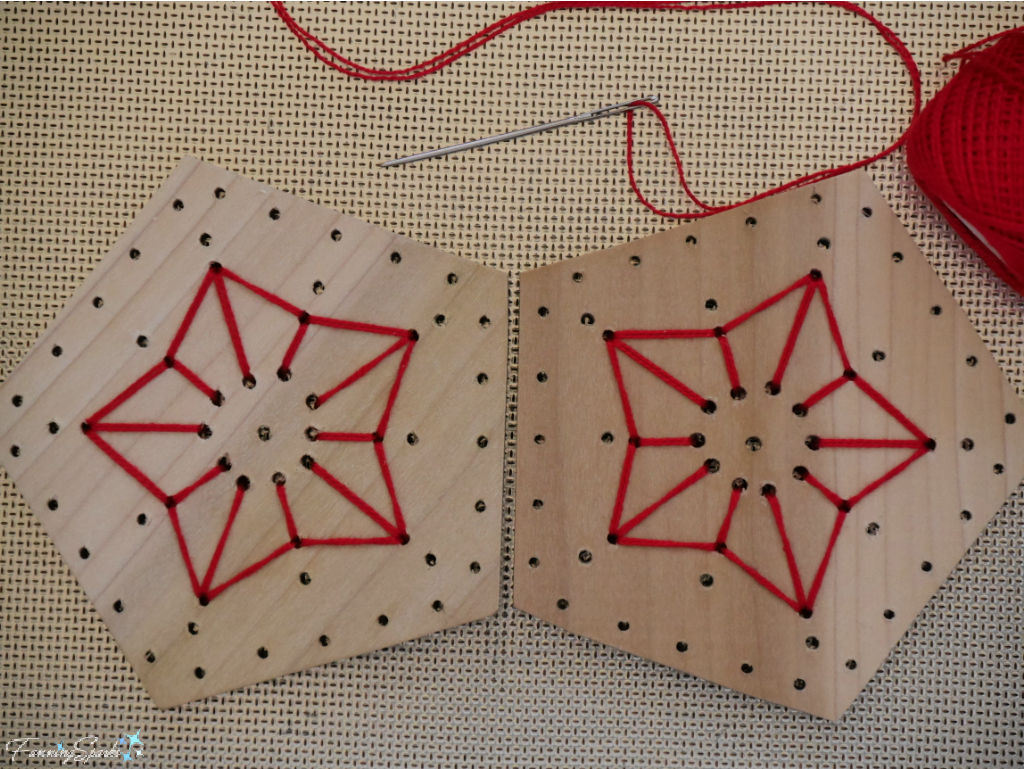 Step 8b. Thread the needle with a 20” length of pearl cotton thread. This step is sewn with a single thread. Hold the 2 pentagons at an angle. Bring the needle up from the back through the first hole in the first pentagon. Pull the thread out through to the front leaving about a 1 ½-2 ½“ tail at the back.
Step 8b. Thread the needle with a 20” length of pearl cotton thread. This step is sewn with a single thread. Hold the 2 pentagons at an angle. Bring the needle up from the back through the first hole in the first pentagon. Pull the thread out through to the front leaving about a 1 ½-2 ½“ tail at the back.
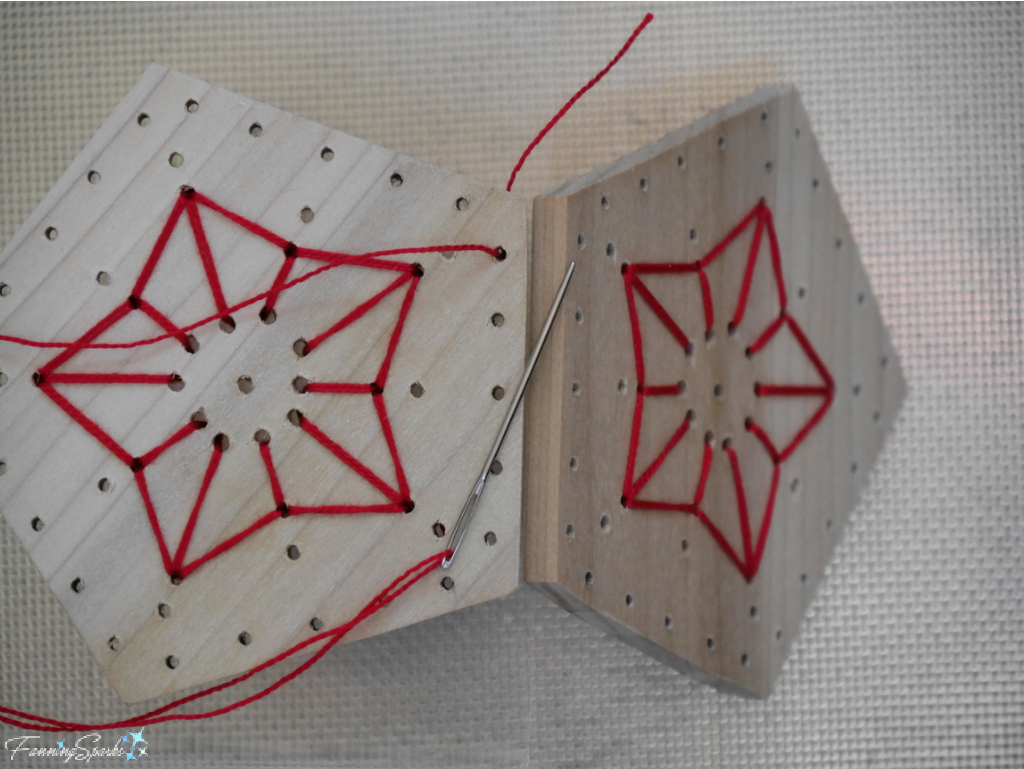 Step 8c. Push the needle down, from the front, through the matching first hole in the second pentagon. Pull the thread out through to the back. Pull the needle back through the first hole, from the back to the front, in the first pentagon. Push the needle down, from the front to the back, in the first hole of the second pentagon. This will result in 2 visible stitches on the front face (as shown below). Holding the 2 pentagons at an angle, pull the thread snuggly.
Step 8c. Push the needle down, from the front, through the matching first hole in the second pentagon. Pull the thread out through to the back. Pull the needle back through the first hole, from the back to the front, in the first pentagon. Push the needle down, from the front to the back, in the first hole of the second pentagon. This will result in 2 visible stitches on the front face (as shown below). Holding the 2 pentagons at an angle, pull the thread snuggly.
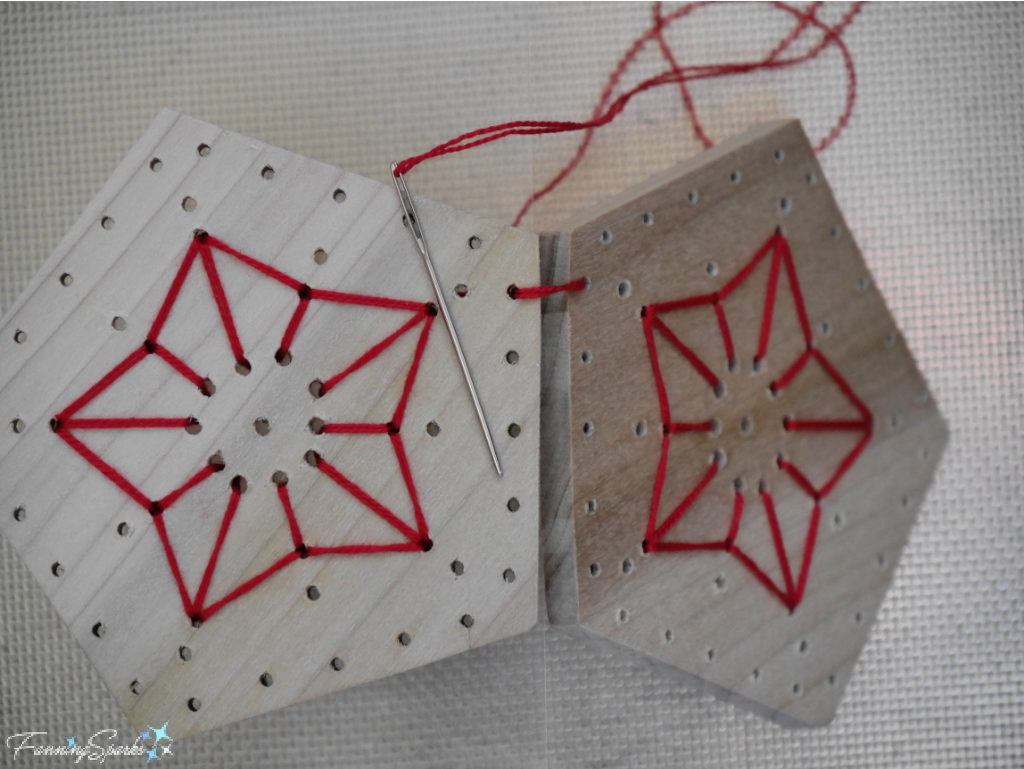 Step 8d. Follow the process described in Step 8c in the remaining 4 holes. The front should look like this.
Step 8d. Follow the process described in Step 8c in the remaining 4 holes. The front should look like this.
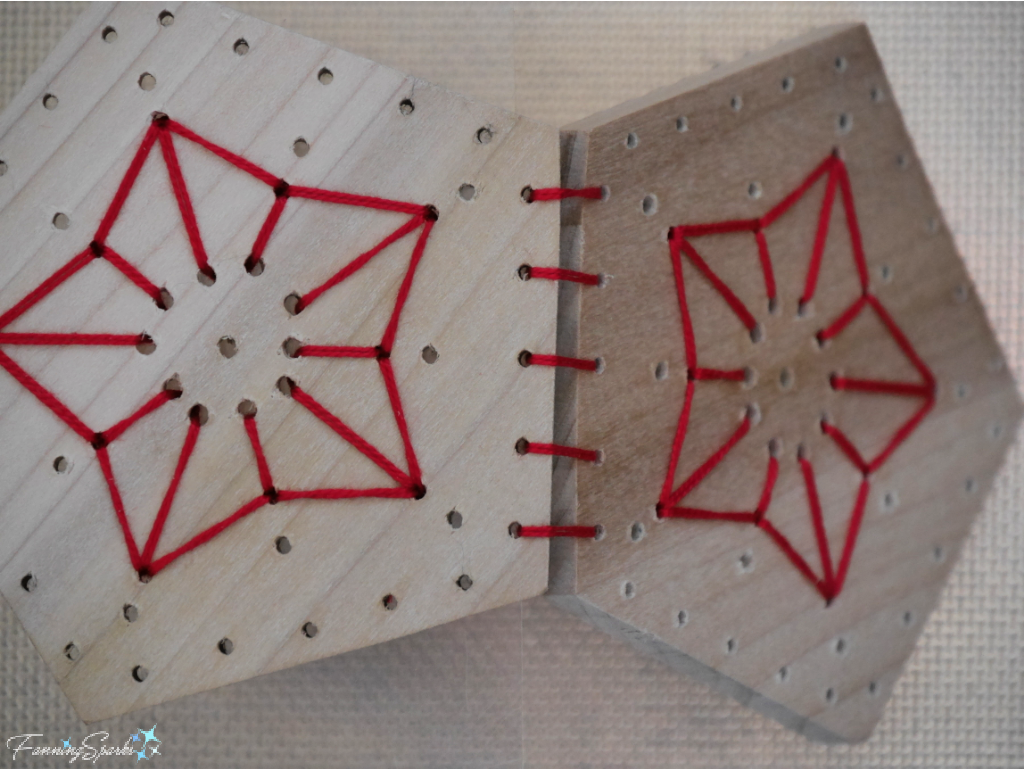 Step 8e. At the end, pull the thread to the back and tie the thread ends in a double knot. The back should look like this.
Step 8e. At the end, pull the thread to the back and tie the thread ends in a double knot. The back should look like this.
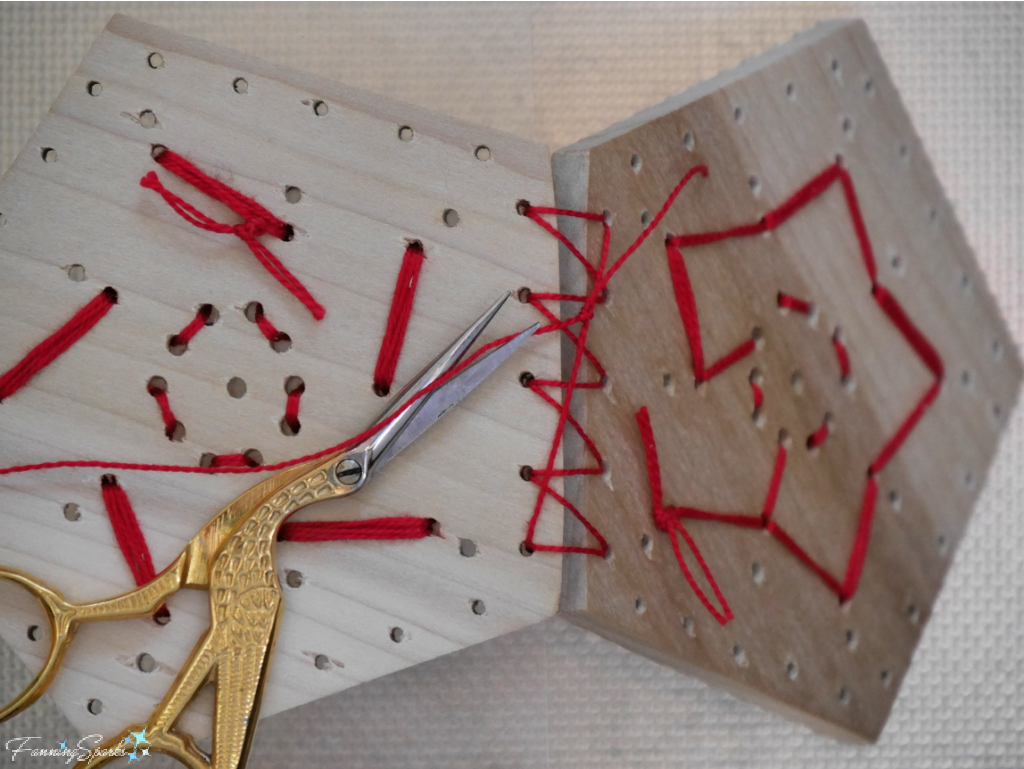 Step 8f. Continue to connect pentagons in this same way until a row of 5 is completed.
Step 8f. Continue to connect pentagons in this same way until a row of 5 is completed.
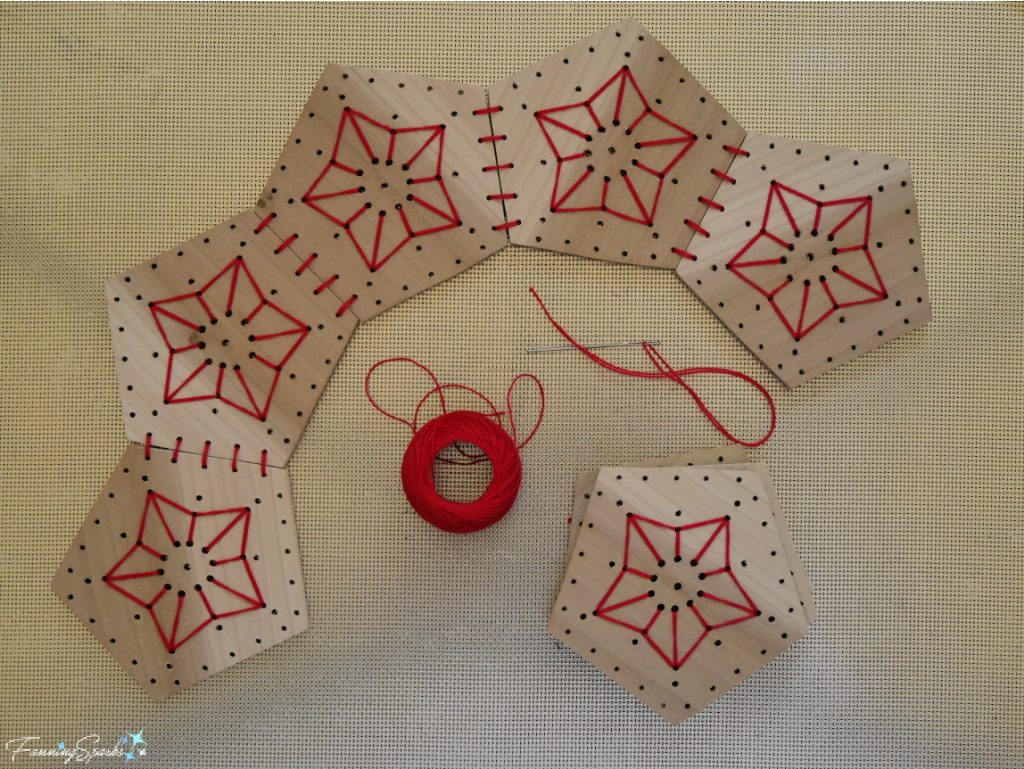 Step 8g. Pull the first and last pentagon of the row together to form a ring. If it’s too difficult to form a ring, one or more of the connections may be too tight. Adjust accordingly. Align the edges of the first and last pentagon. Connect in the same way as above in Steps 8b-8e.
Step 8g. Pull the first and last pentagon of the row together to form a ring. If it’s too difficult to form a ring, one or more of the connections may be too tight. Adjust accordingly. Align the edges of the first and last pentagon. Connect in the same way as above in Steps 8b-8e.
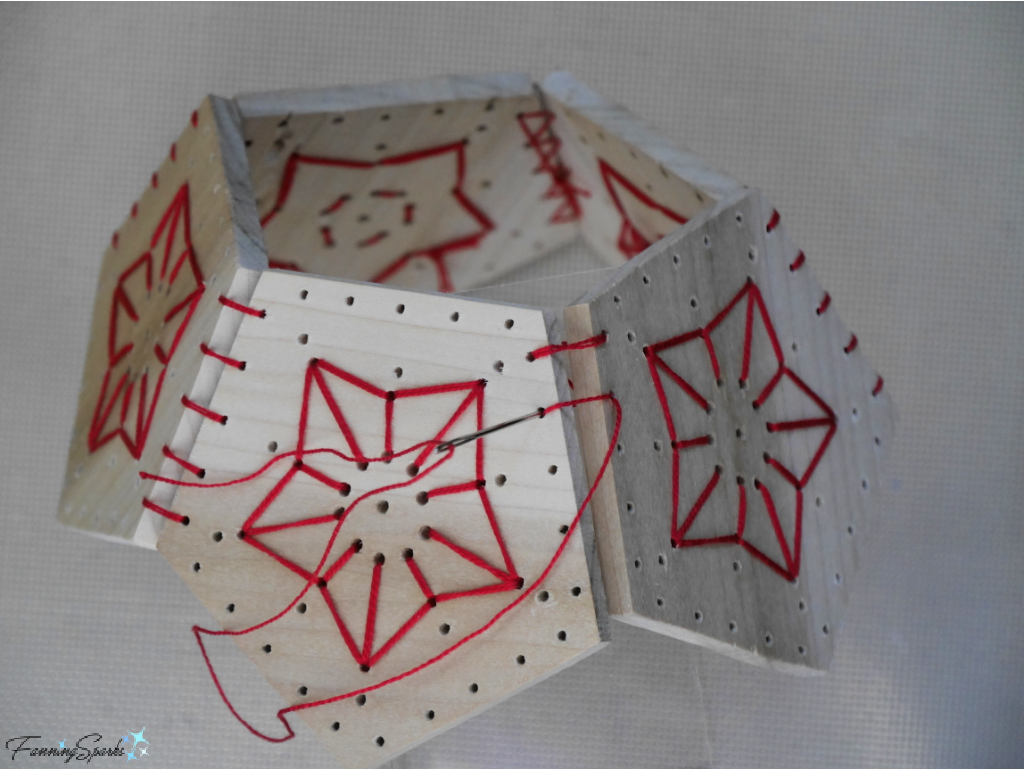 Step 9. Finish Bottom Edge The bottom edge is finished with a blanket stitch. Thread the needle with a 60” length of pearl cotton. This step is sewn with a single thread. Select a hole to the right of a connection as the starting point. Begin at back leaving a 3” tail. Pull tail up to top edge and tack down with painter’s tape.
Step 9. Finish Bottom Edge The bottom edge is finished with a blanket stitch. Thread the needle with a 60” length of pearl cotton. This step is sewn with a single thread. Select a hole to the right of a connection as the starting point. Begin at back leaving a 3” tail. Pull tail up to top edge and tack down with painter’s tape.
TIP: Sewing with 60” of thread can be tricky. Work slowly and smooth out the thread as you go to prevent knotting.
Step 9a. To start the stitching, bring the needle through the hole from the back to the front. Wrap the thread neatly around the bottom edge. Bring the needle through the same hole from the back to the front again. Wrap the second line of thread neatly around the bottom edge beside the first line. Keeping the needle at the back, pass it under the tacked-down thread tail (stitching from left to right) and into the back of the next hole.
 Step 9b. Continue around the entire bottom edge in the same way. Bring the needle through the hole from the back to the front. Wrap the thread neatly around the bottom edge. Bring the needle through the same hole from the back to the front again. Wrap the second line of thread neatly around the bottom edge beside the first line. Keeping the needle at the back, pass it under the previous horizontal stitch (stitching from left to right) and into the back of the next hole. Do not be concerned if the thread “cuts the corner” at the connections since this will not be visible.
Step 9b. Continue around the entire bottom edge in the same way. Bring the needle through the hole from the back to the front. Wrap the thread neatly around the bottom edge. Bring the needle through the same hole from the back to the front again. Wrap the second line of thread neatly around the bottom edge beside the first line. Keeping the needle at the back, pass it under the previous horizontal stitch (stitching from left to right) and into the back of the next hole. Do not be concerned if the thread “cuts the corner” at the connections since this will not be visible.
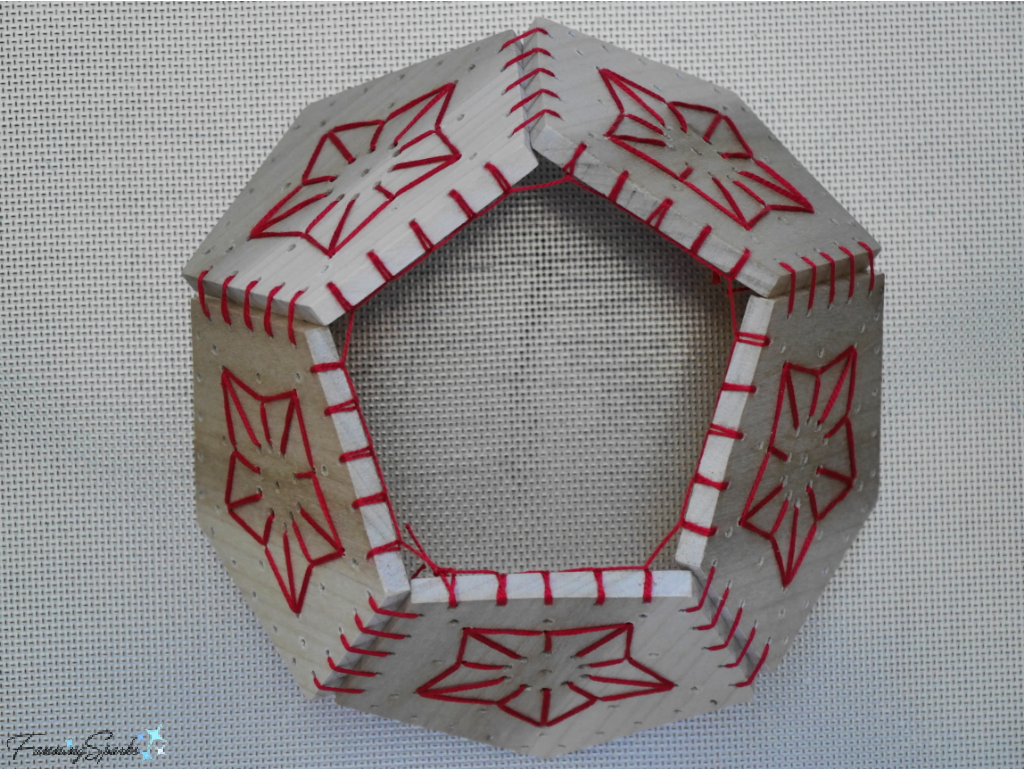 Step 10. Assemble Sphere Build up the sphere by connecting the remaining pentagons one at a time. The top will be the most visible so you may want to set aside your best pentagon for this position. The top will be added last. Work around the sphere building a second ring. Use the process described in Steps 8b-8e, to connect the pentagons. Stitch all connecting sides of a pentagon before attaching another one.
Step 10. Assemble Sphere Build up the sphere by connecting the remaining pentagons one at a time. The top will be the most visible so you may want to set aside your best pentagon for this position. The top will be added last. Work around the sphere building a second ring. Use the process described in Steps 8b-8e, to connect the pentagons. Stitch all connecting sides of a pentagon before attaching another one.
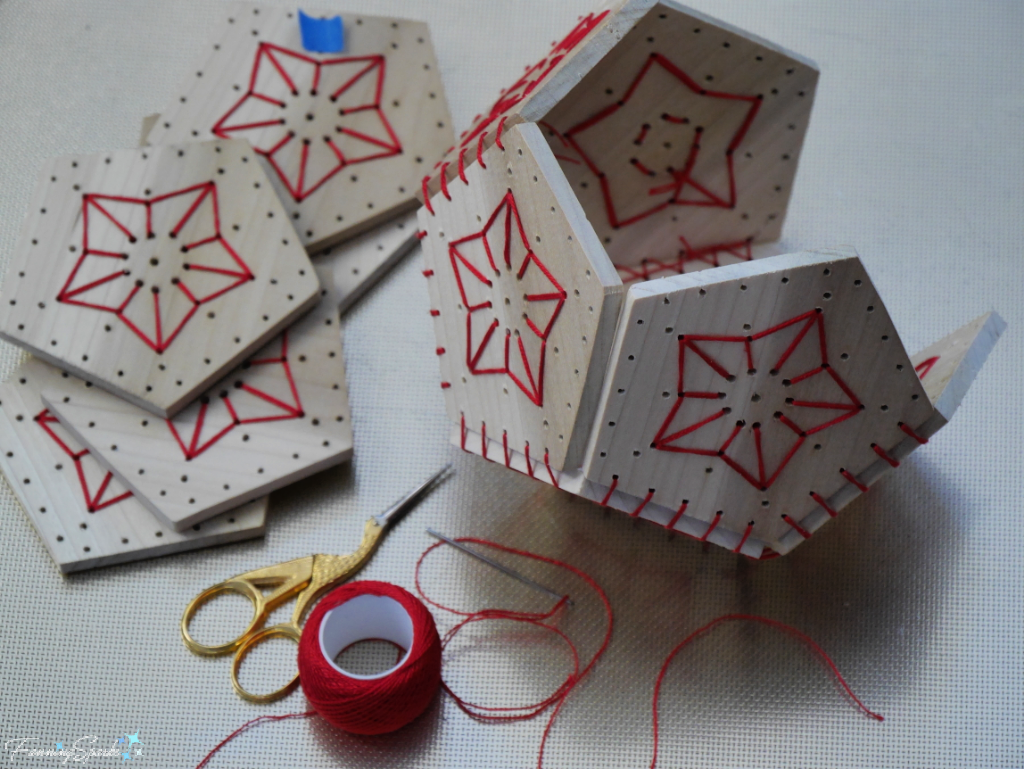 Step 11. Connect Top Place the final pentagon on the top of the sphere aligning all edges. Thread the needle with an 84” length of pearl cotton thread. This step is sewn with a single thread. Select a hole to the right of a connection as the starting point. Begin at the back leaving a 4-6” tail. Pull the thread tail down to the bottom edge and tack it down with painter’s tape. Stitch around all 5 sides of the pentagon before tying off. Follow a process similar to that described in Steps 8b-8e. It is a little tricky to sew this last section since you have to insert your hand inside the sphere. Take your time. Pull out and smooth the full length of the thread as you stitch to prevent knotting. Don’t worry about tightening the knotted tails—a loose knot is fine.
Step 11. Connect Top Place the final pentagon on the top of the sphere aligning all edges. Thread the needle with an 84” length of pearl cotton thread. This step is sewn with a single thread. Select a hole to the right of a connection as the starting point. Begin at the back leaving a 4-6” tail. Pull the thread tail down to the bottom edge and tack it down with painter’s tape. Stitch around all 5 sides of the pentagon before tying off. Follow a process similar to that described in Steps 8b-8e. It is a little tricky to sew this last section since you have to insert your hand inside the sphere. Take your time. Pull out and smooth the full length of the thread as you stitch to prevent knotting. Don’t worry about tightening the knotted tails—a loose knot is fine.
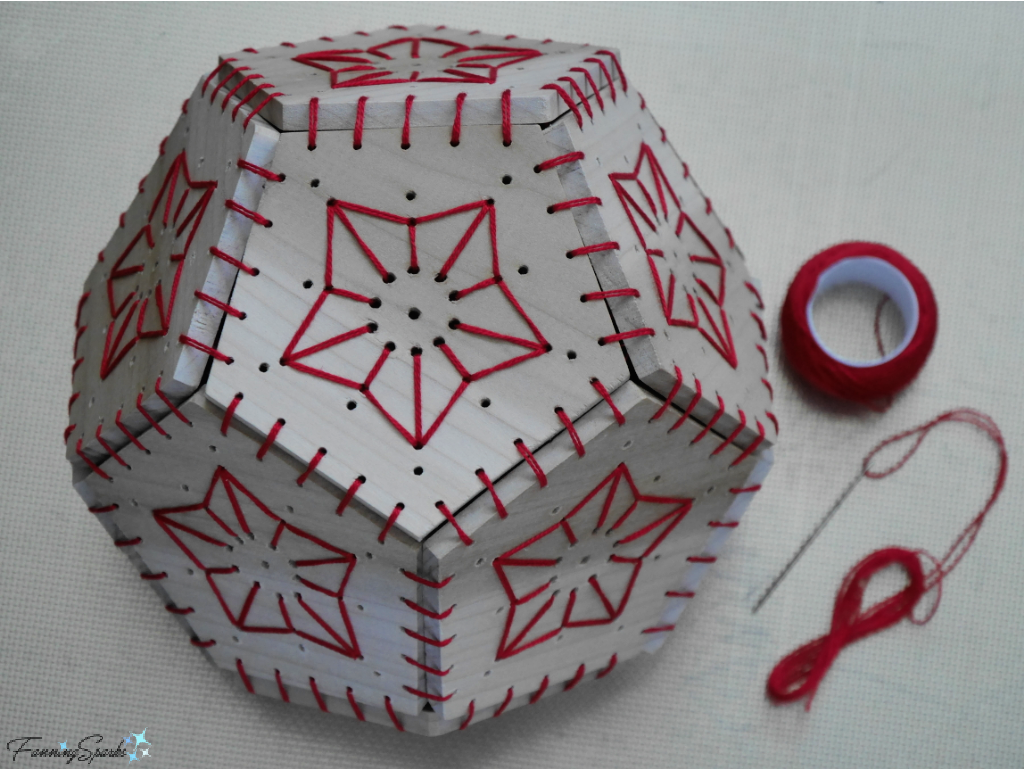 Step 12. Insert Lights (Optional) If desired, slip a set of battery-operated LED lights inside the sphere.
Step 12. Insert Lights (Optional) If desired, slip a set of battery-operated LED lights inside the sphere.
There you have it—your new Starry Stitched Sphere is ready to display!

This Starry Stitched Sphere is the perfect companion for the Diamonds and Beads Wooden Wreath I made last year. See the DIY Tutorial here. 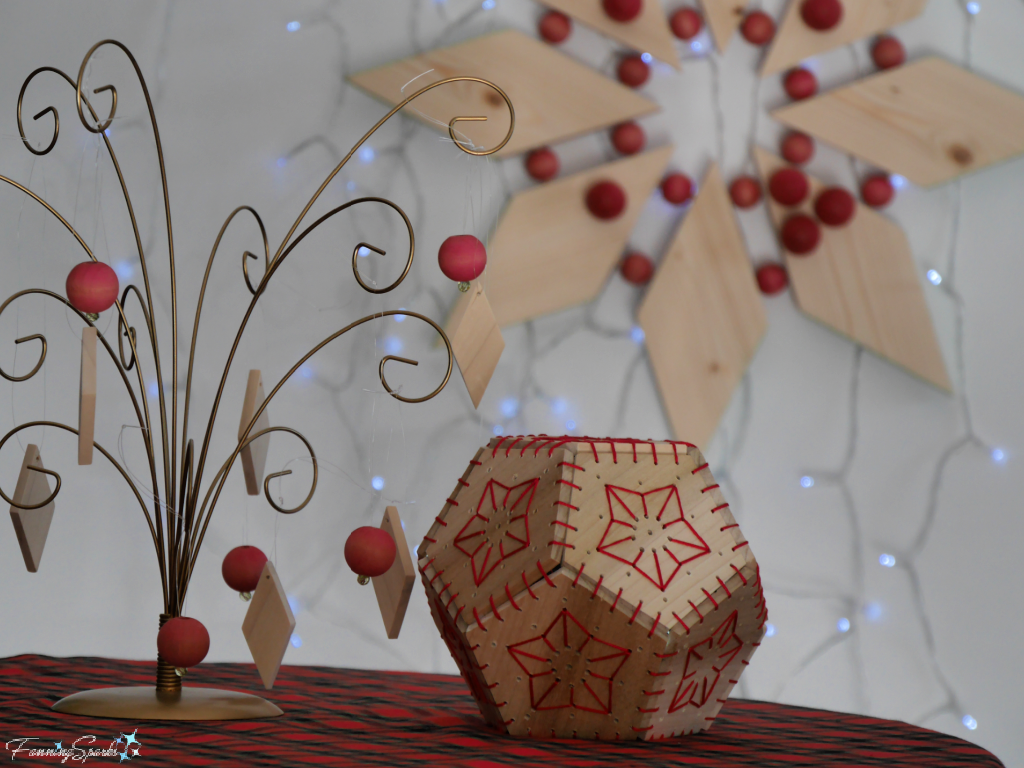
More Info
You can download the Starry Stitched Sphere Pentagon Template – Complimentary Download to print the template for the pentagons.
You may also like the Diamonds and Beads Wooden Wreath which has a similar style. Check out the Diamonds and Beads Wooden Wreath – DIY Tutorial for step-by-step instructions.
Today’s Takeaways
1. Holiday decorating provides an opportunity to get creative and make something new.
2. Natural wood can add warmth and coziness.
3. Consider mixing materials and techniques in unexpected ways.


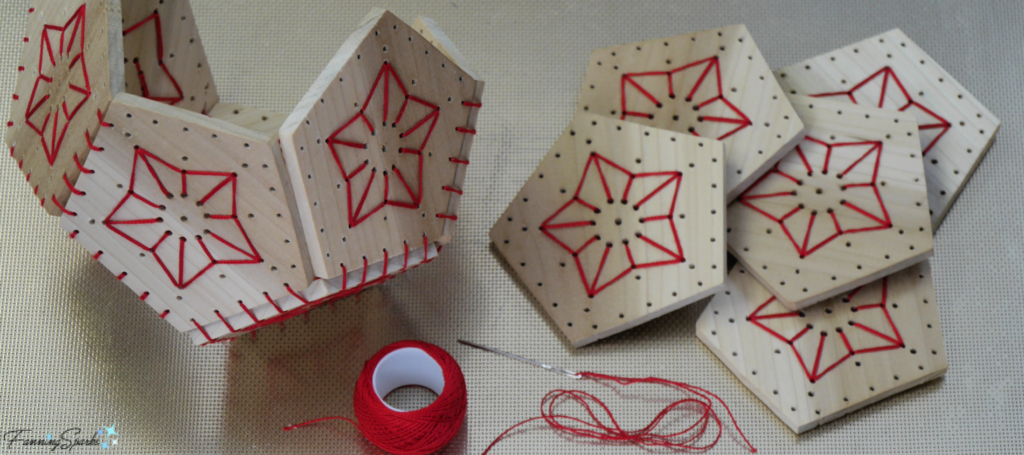

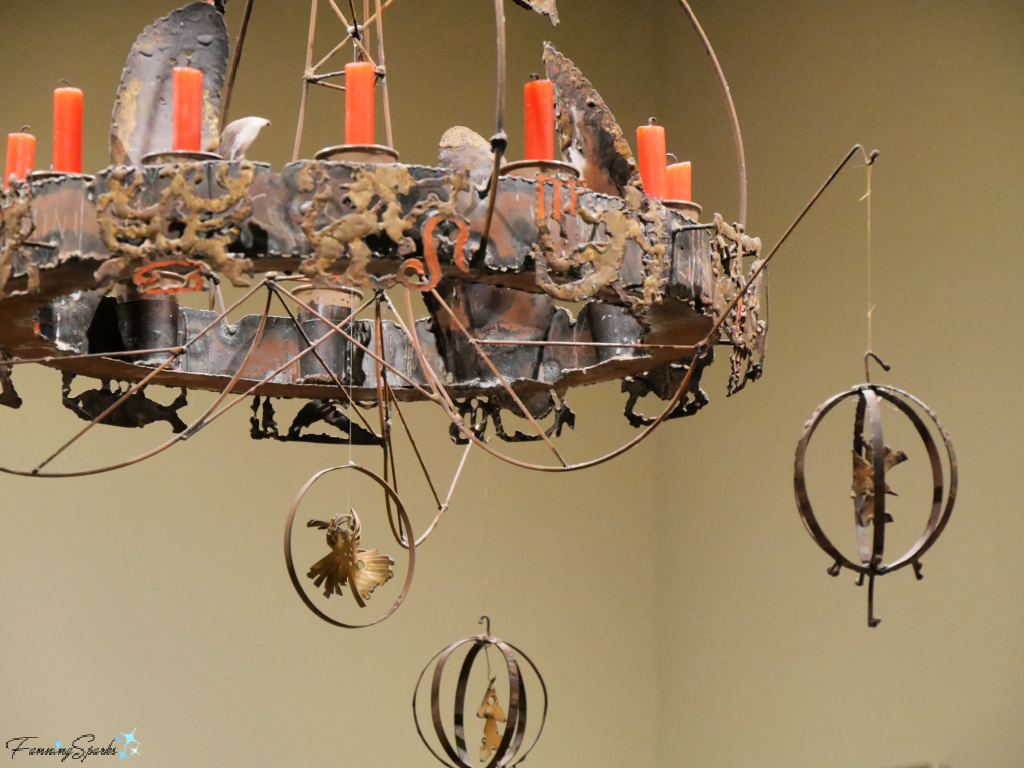

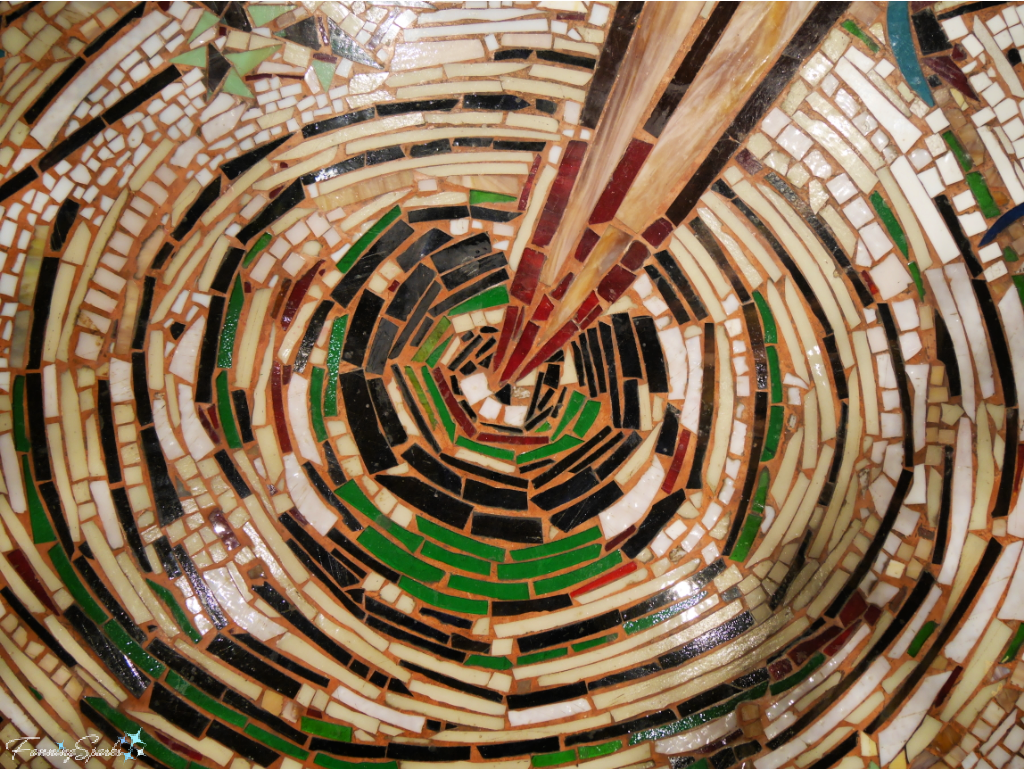

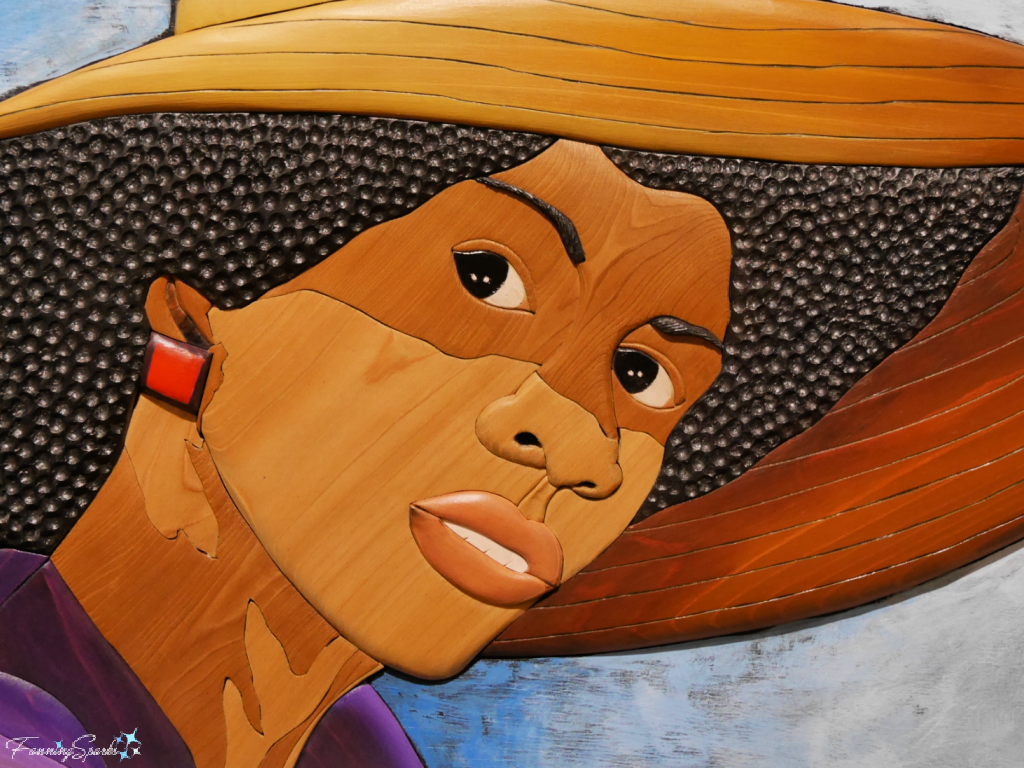
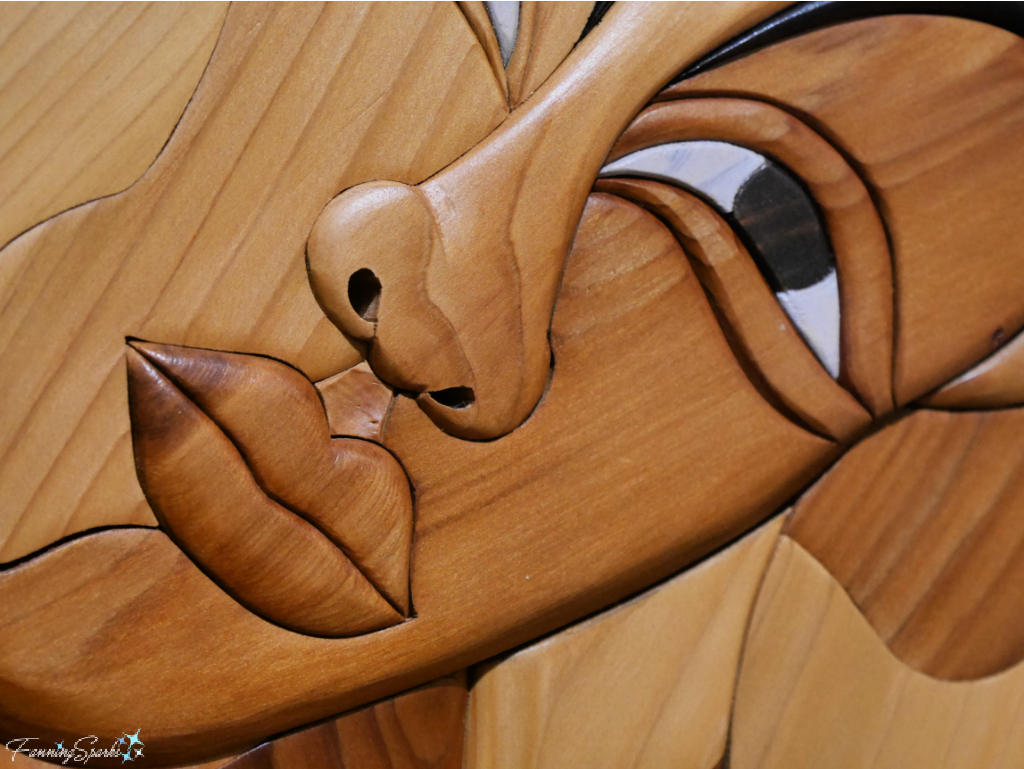
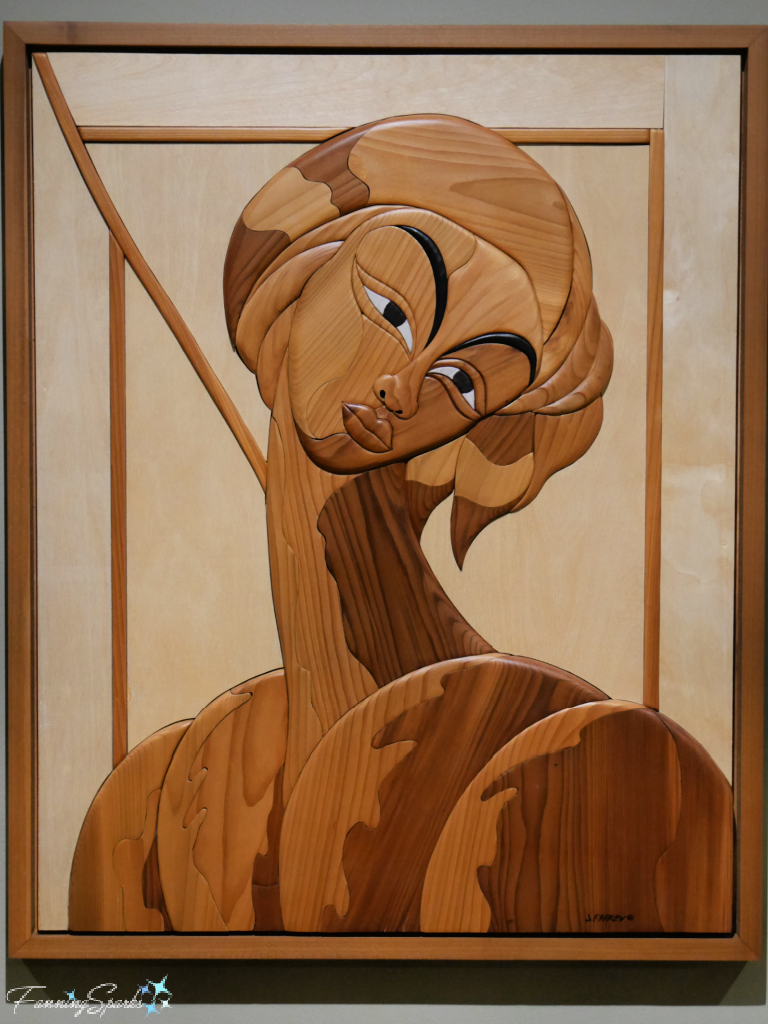
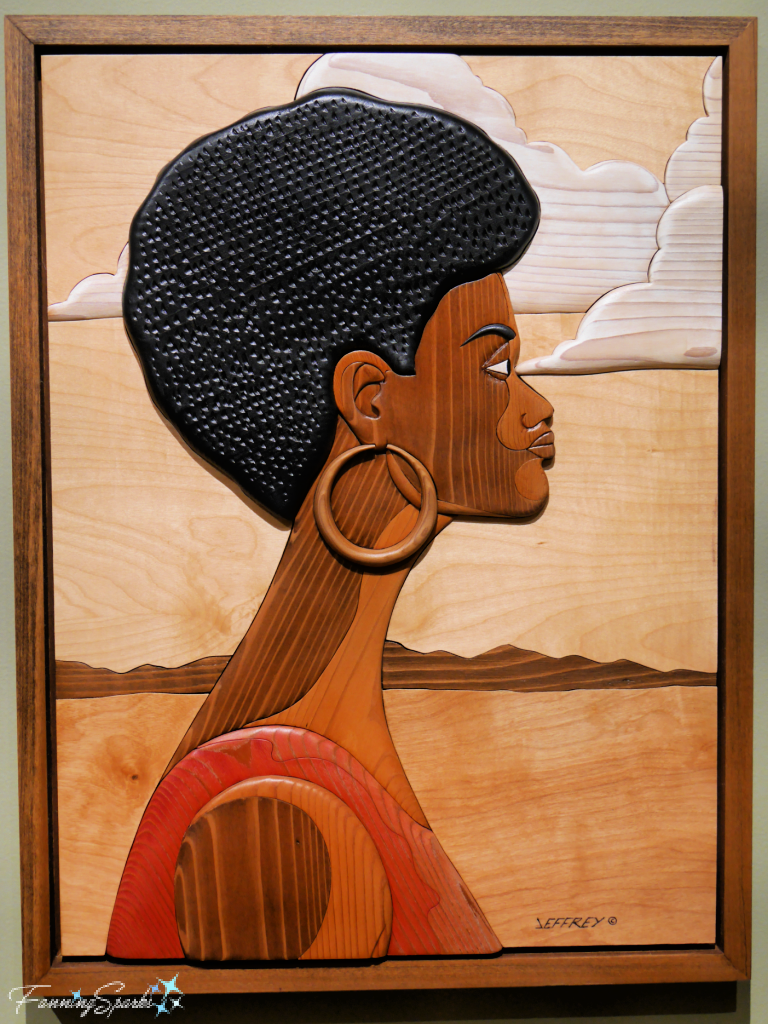
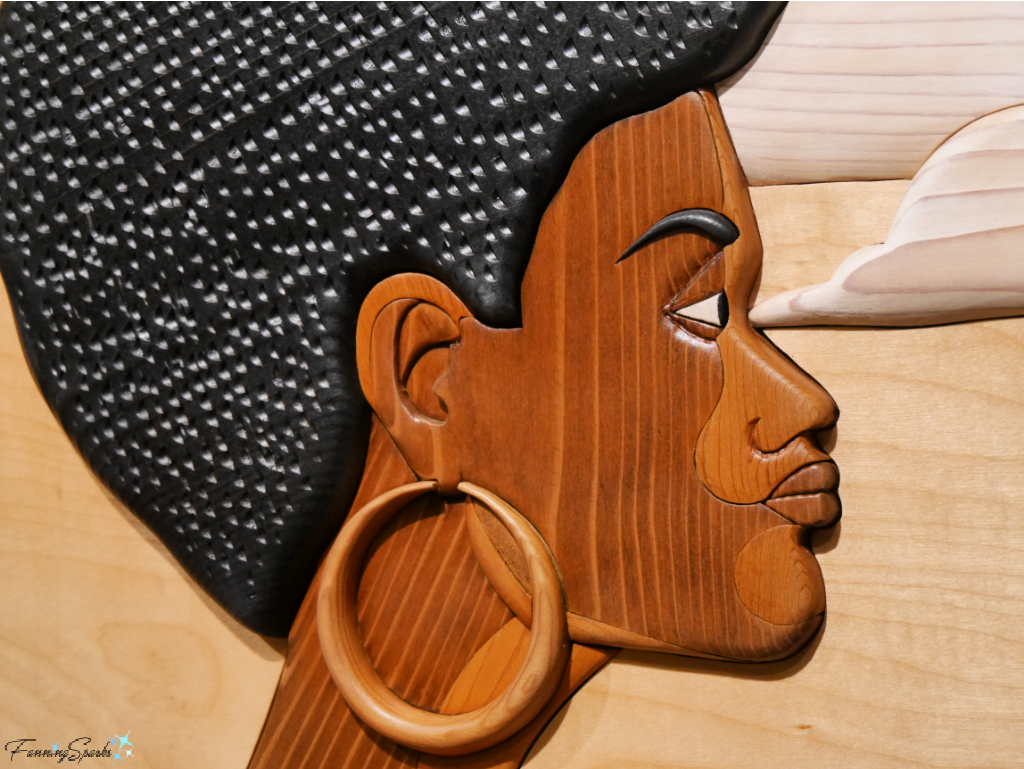
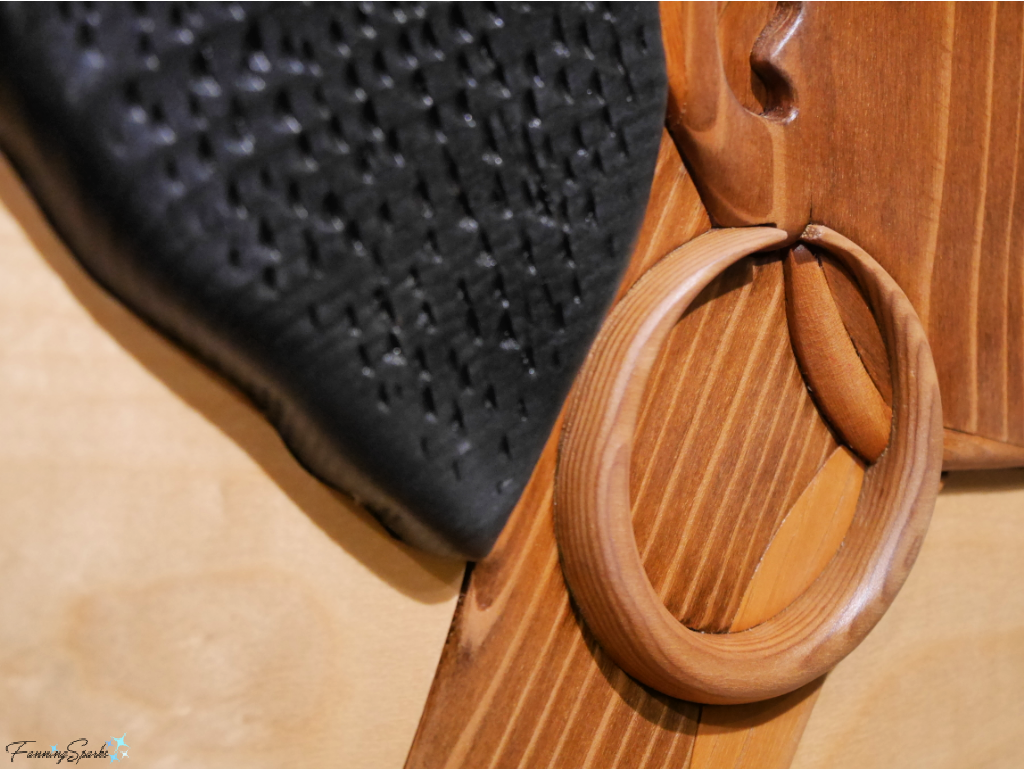
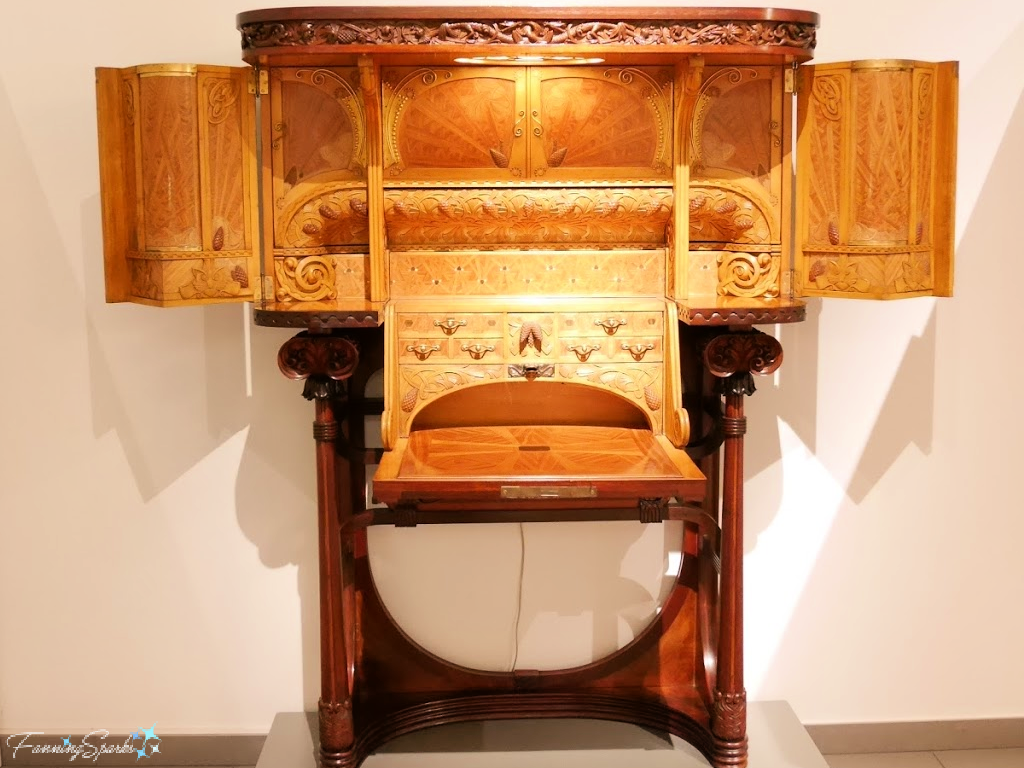
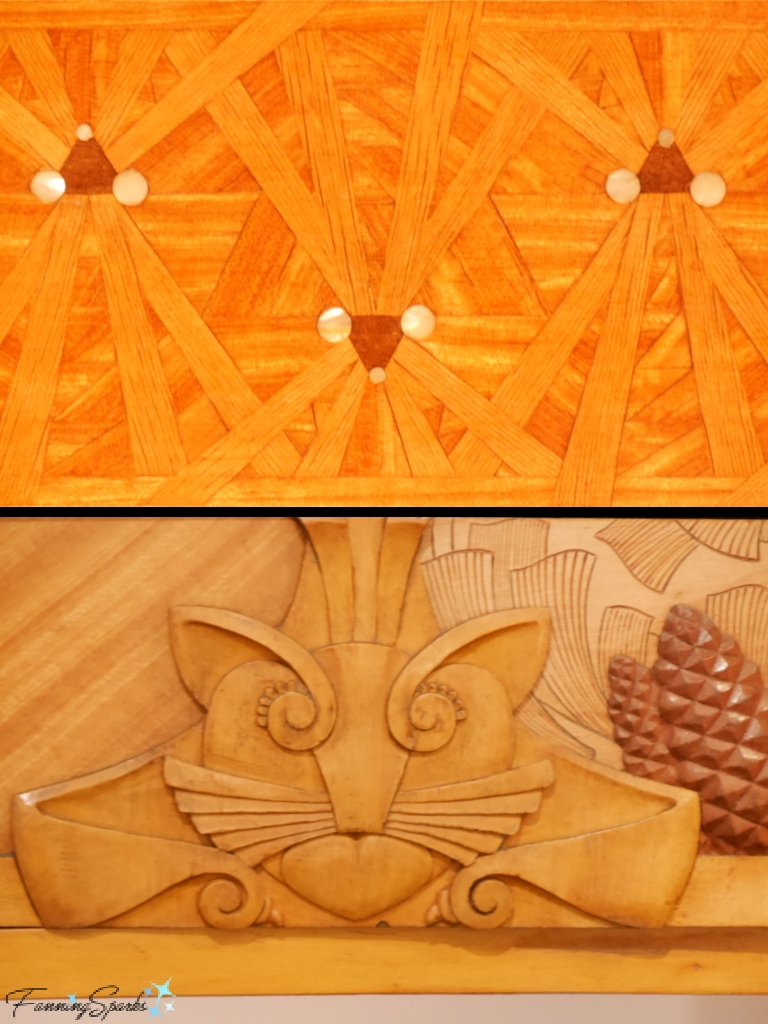
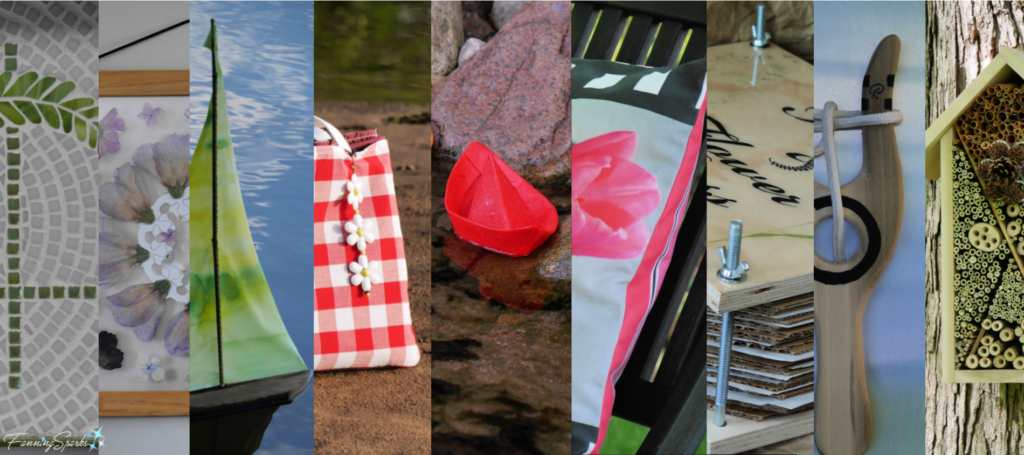
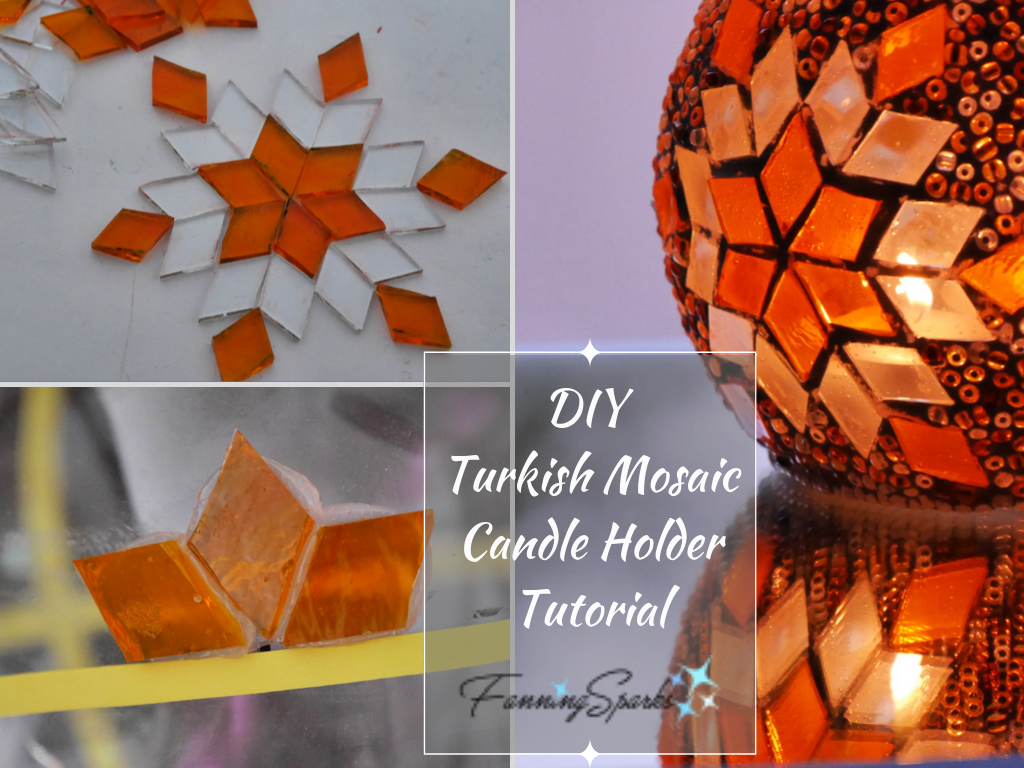
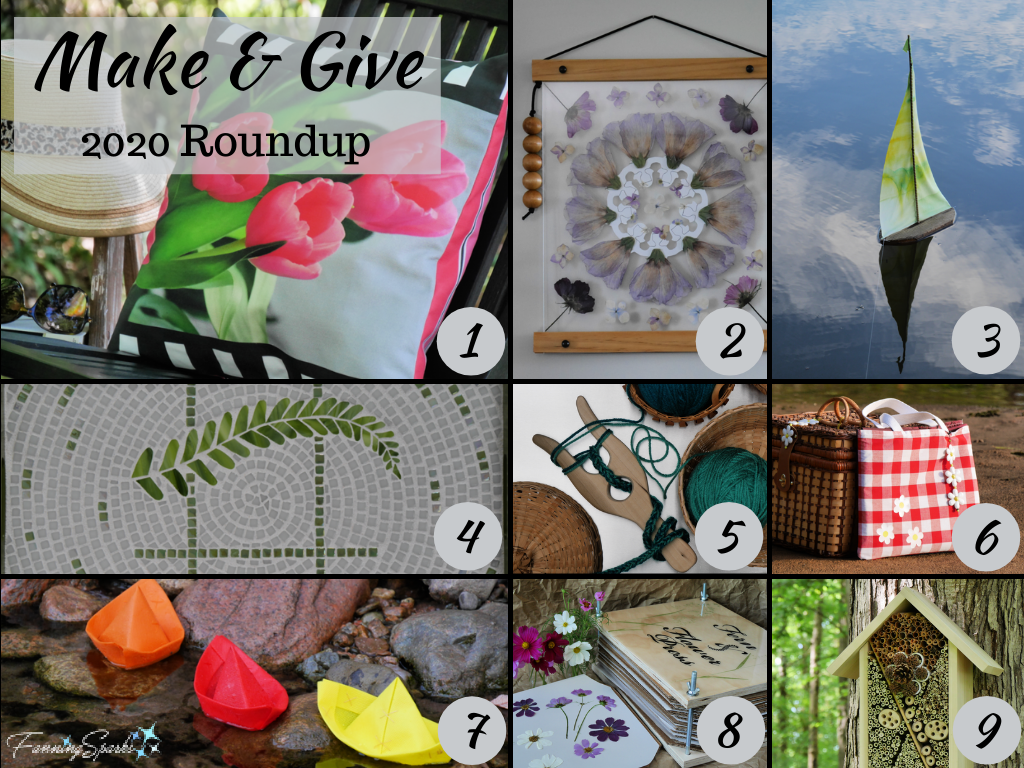
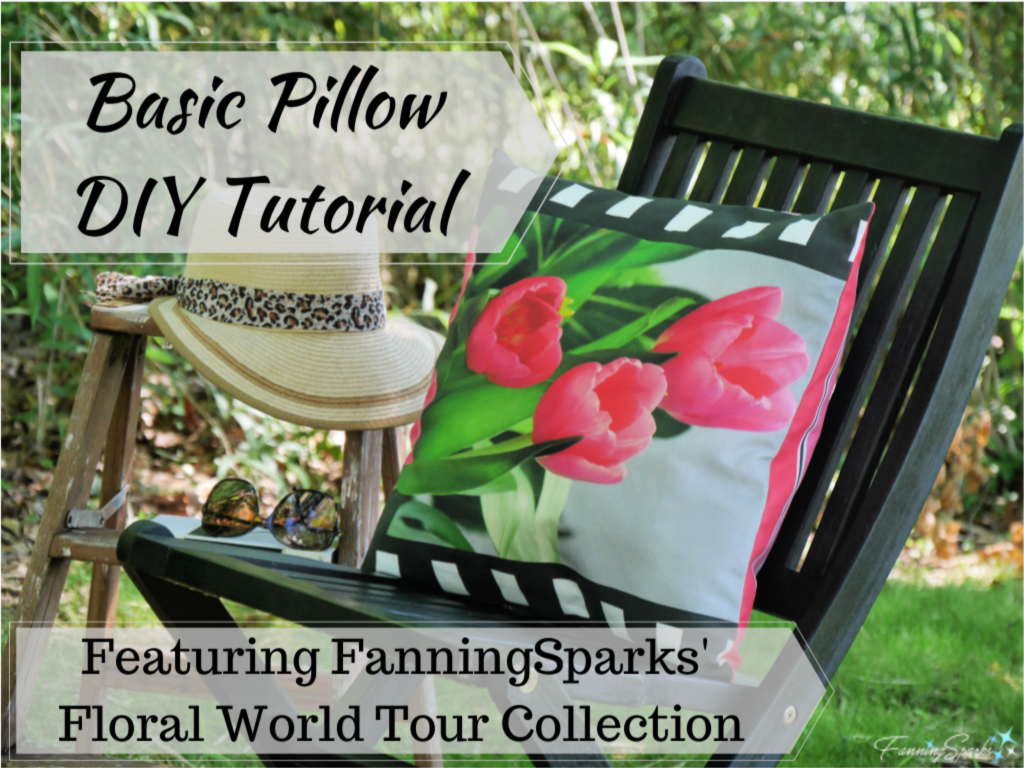
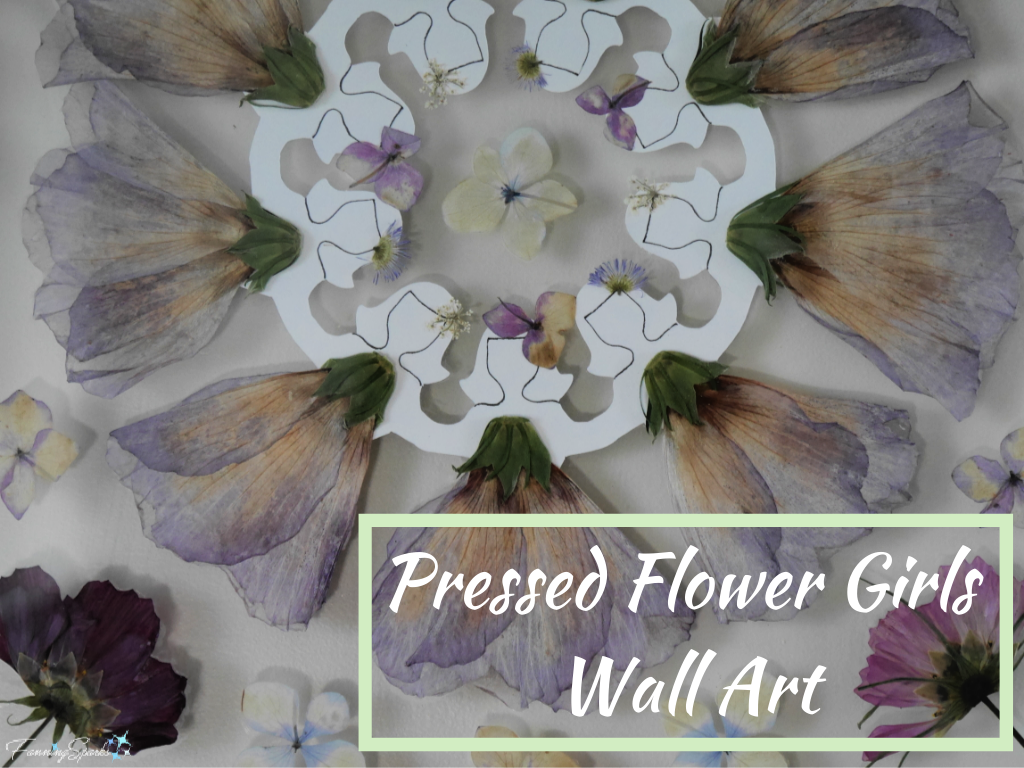

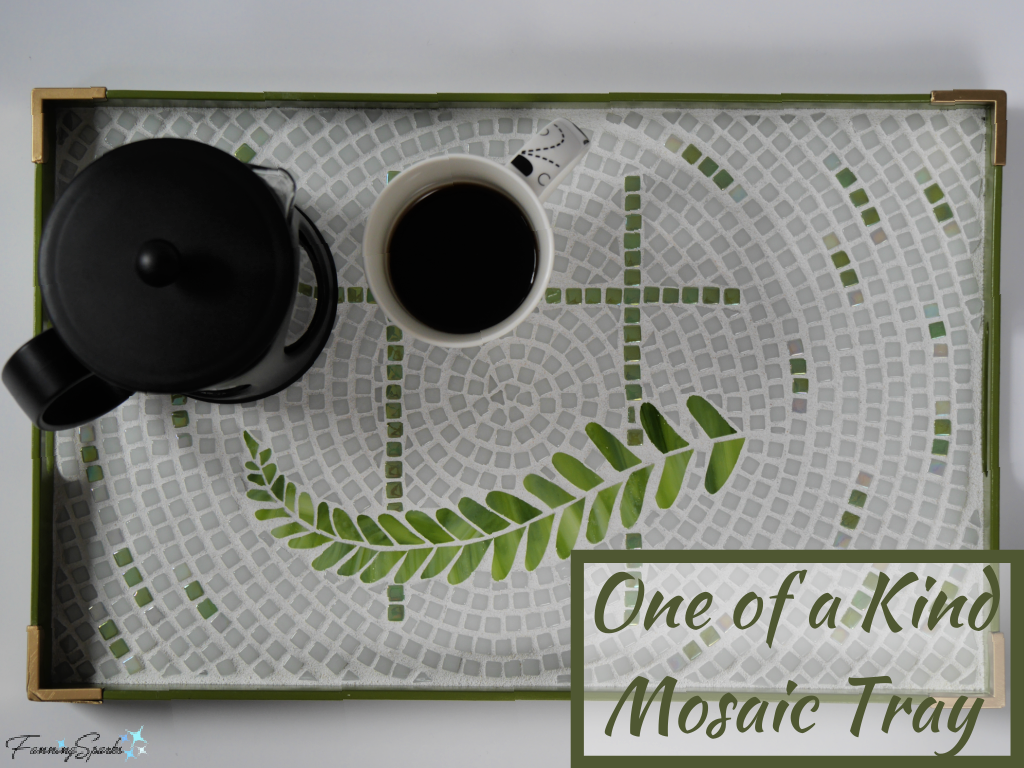

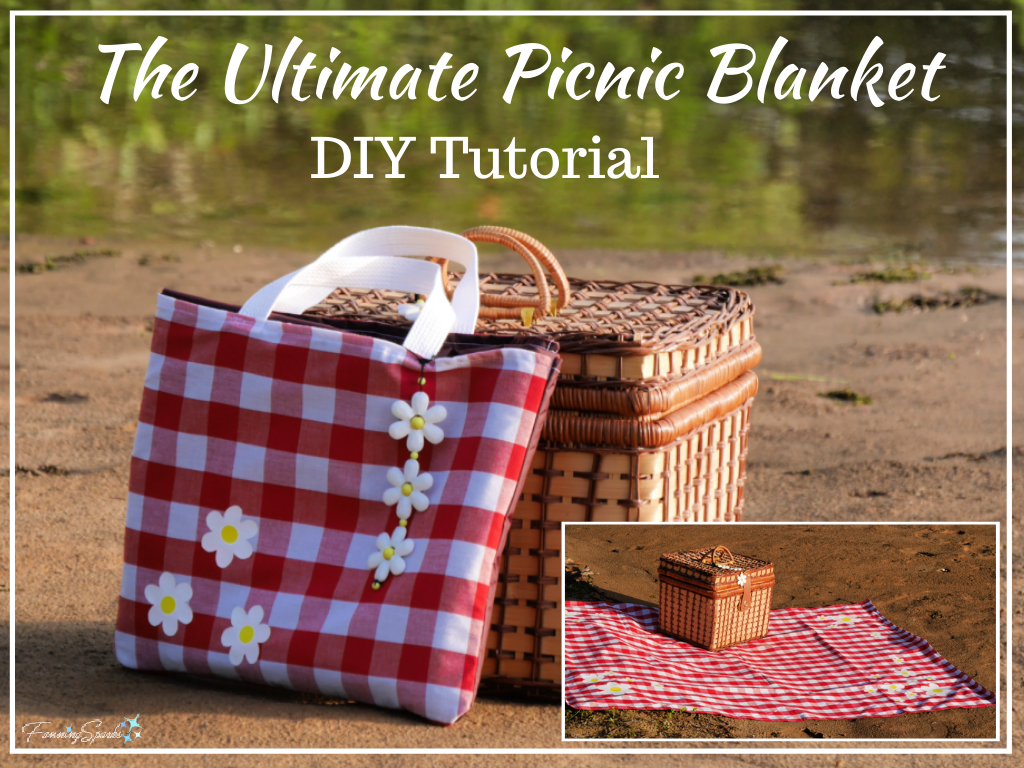
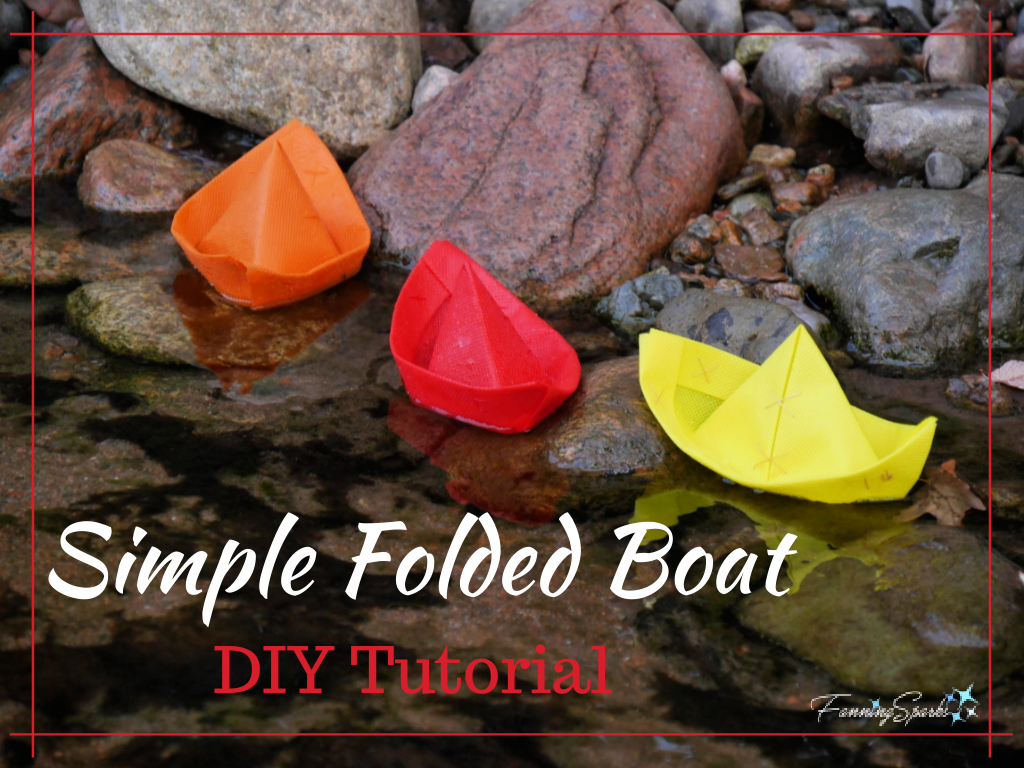
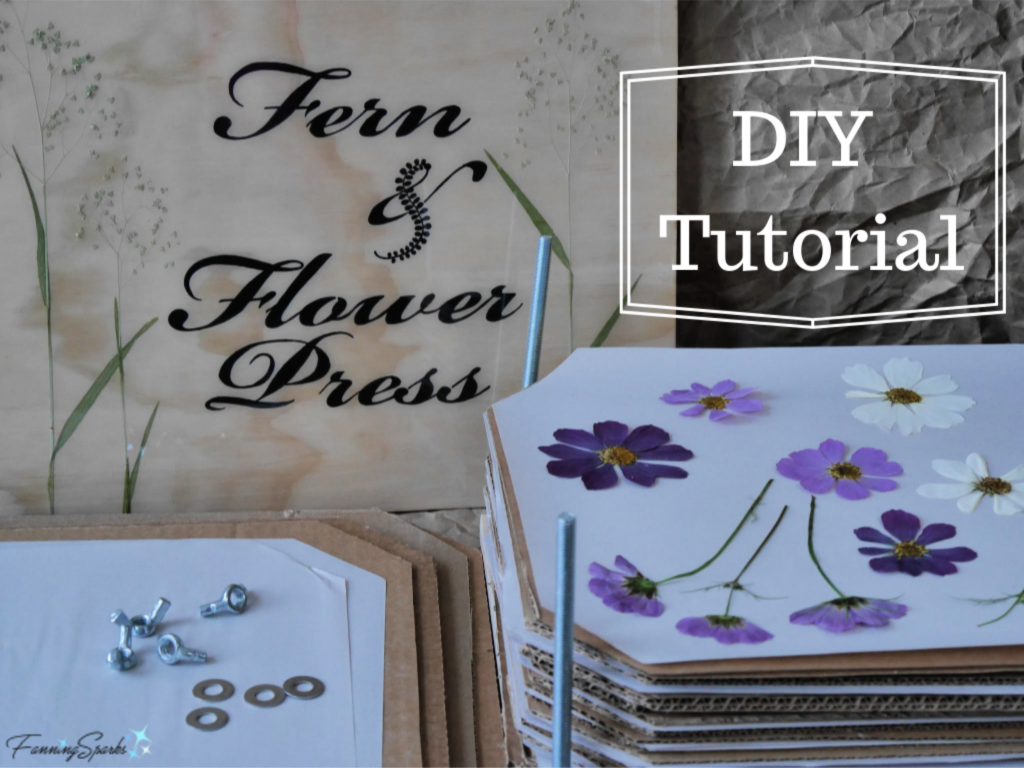
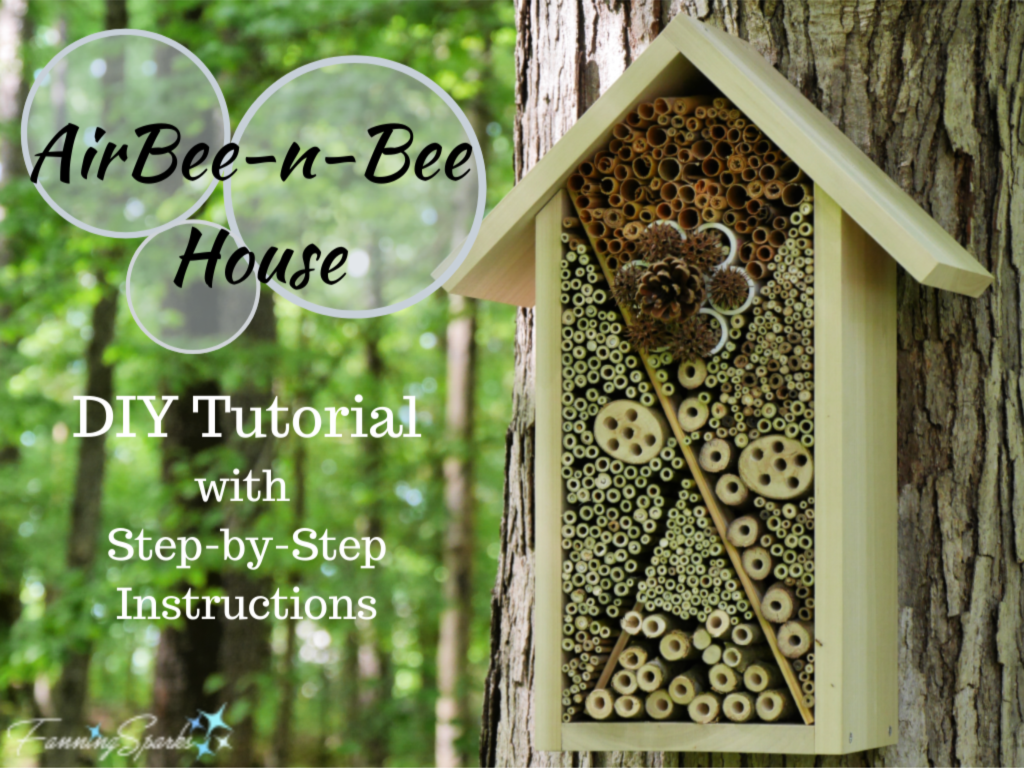
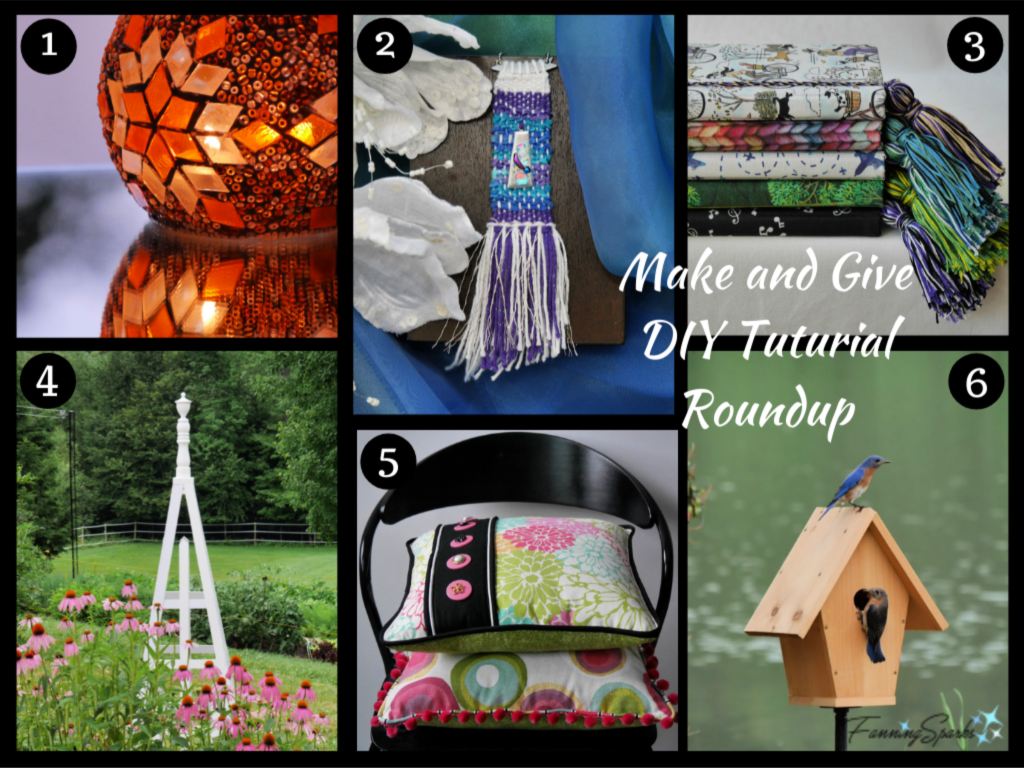
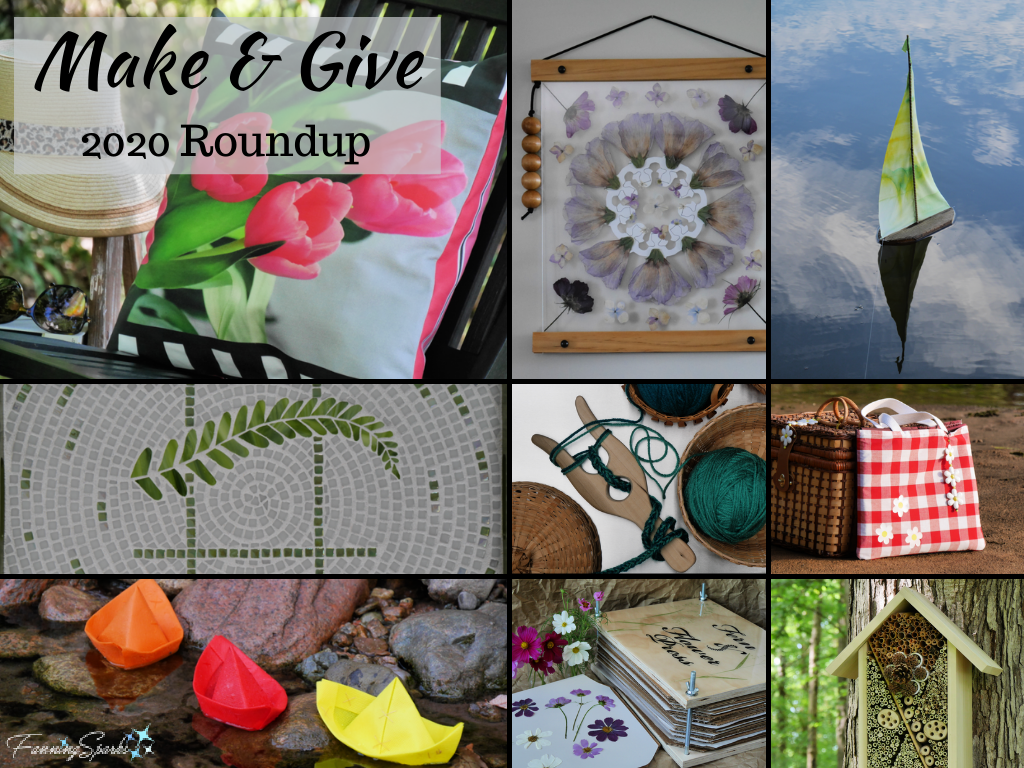
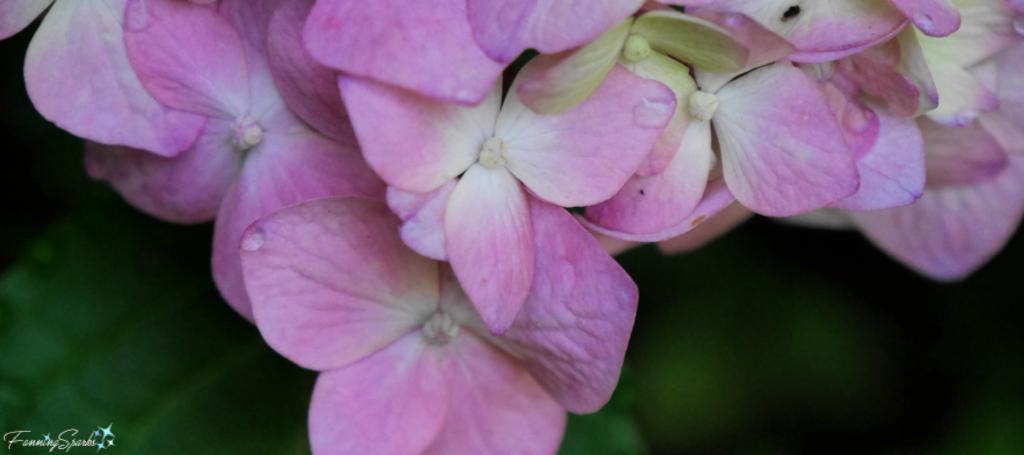

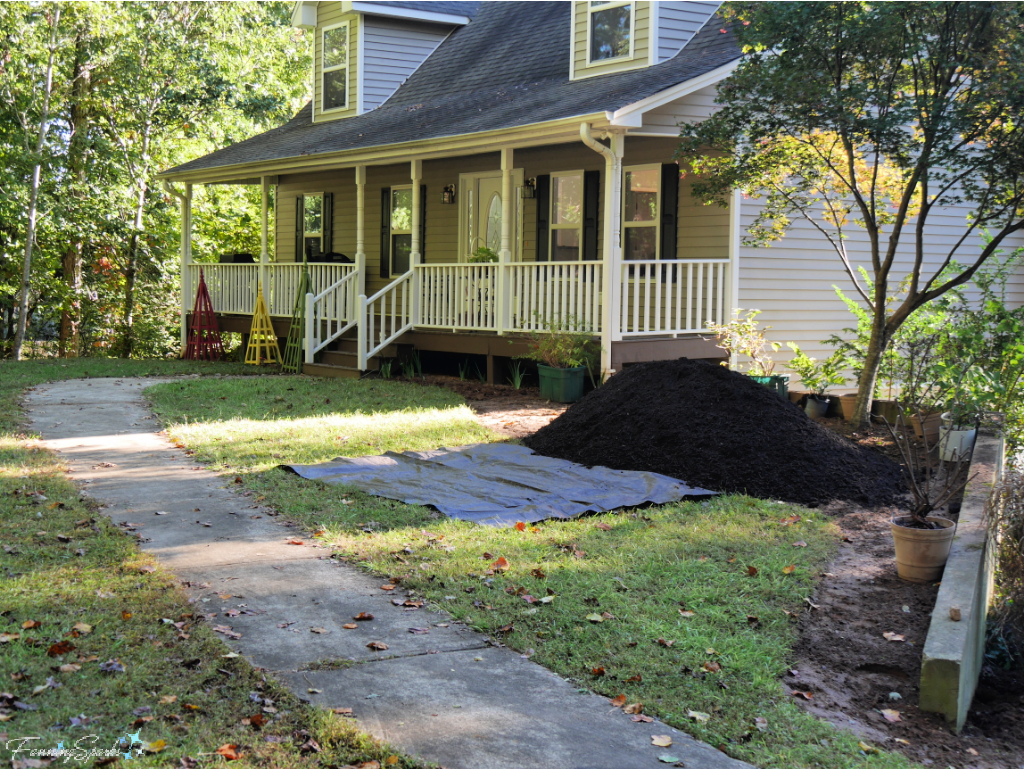
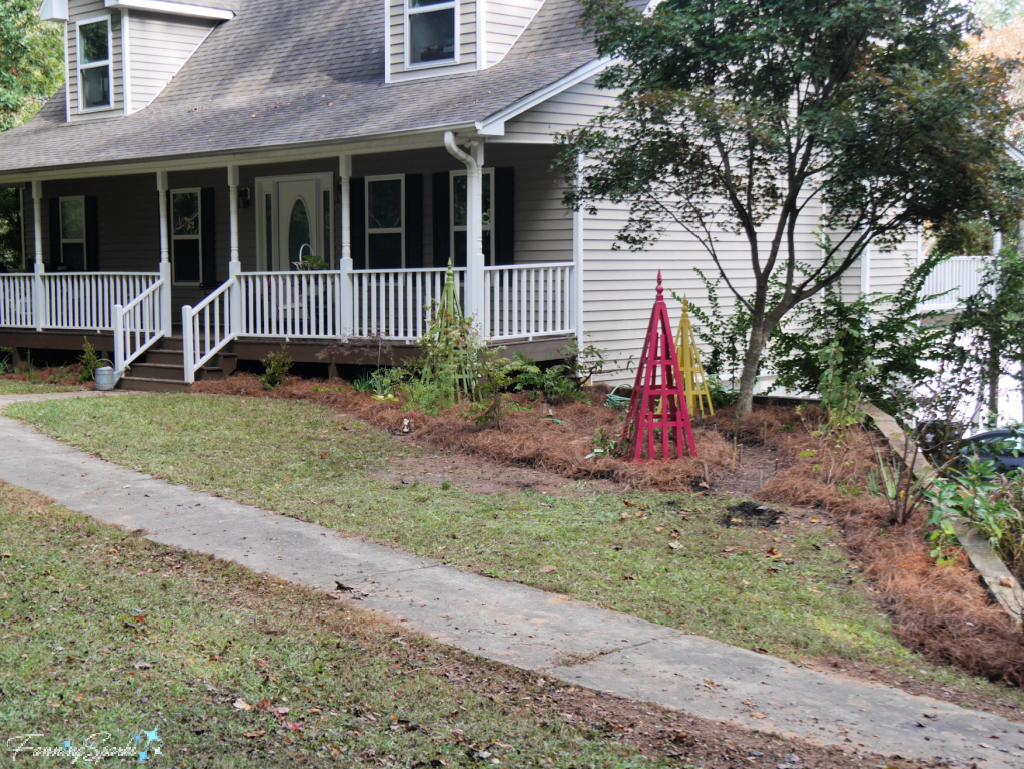
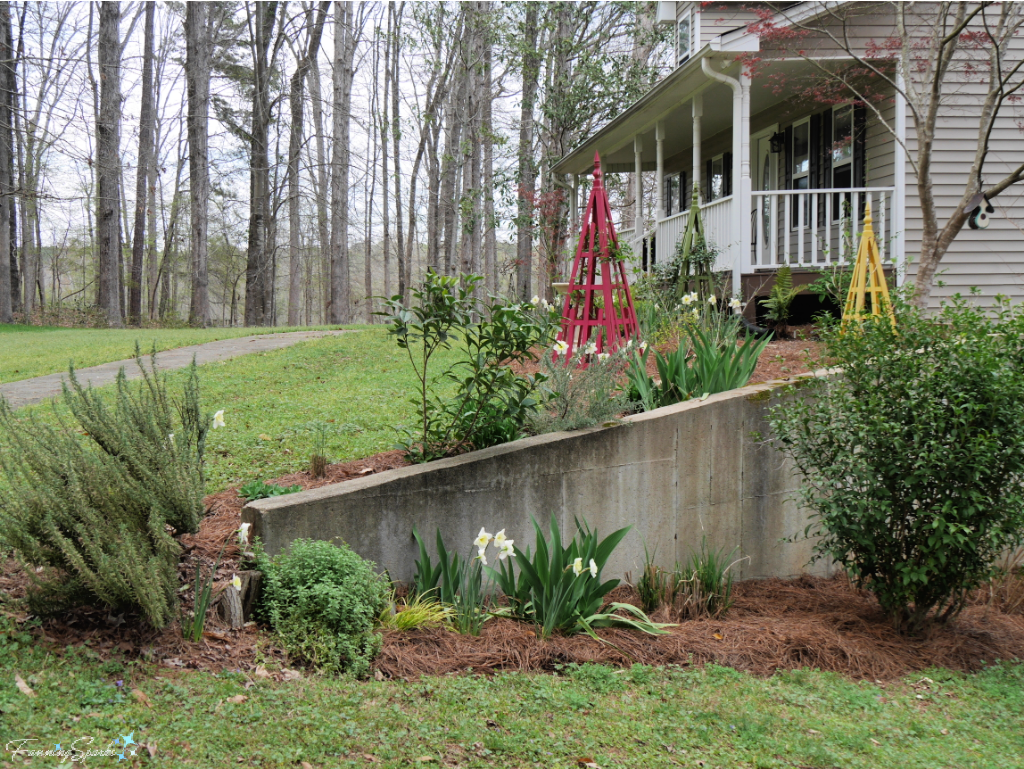
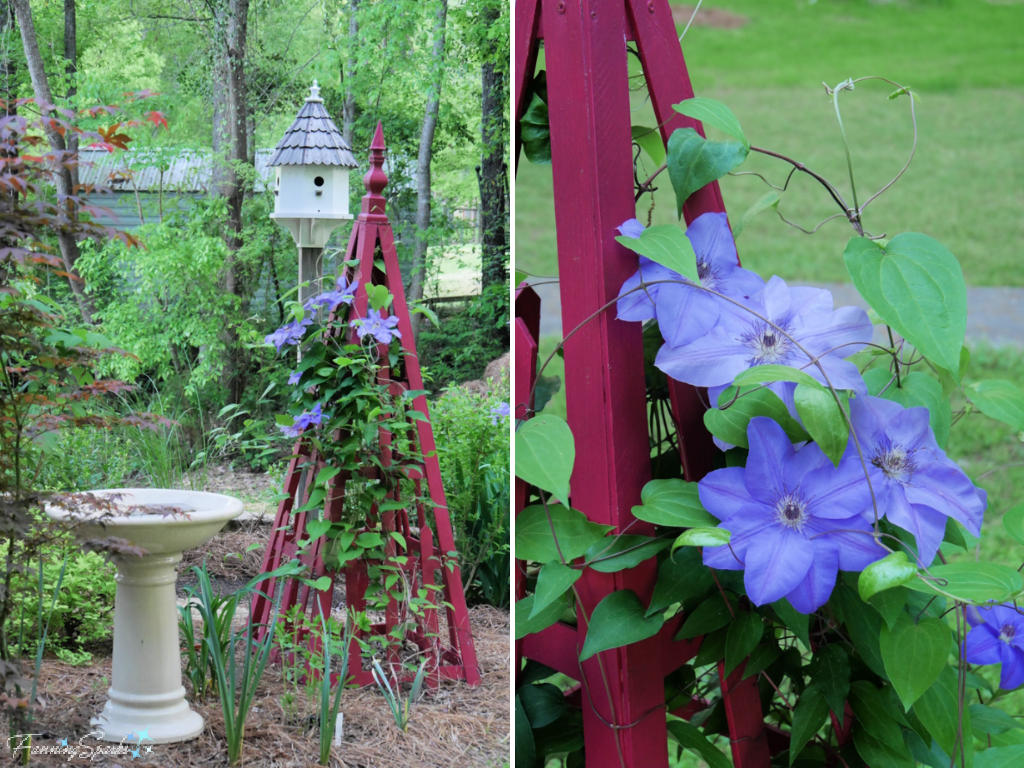 This was also peak season for the spectacular bearded irises.
This was also peak season for the spectacular bearded irises.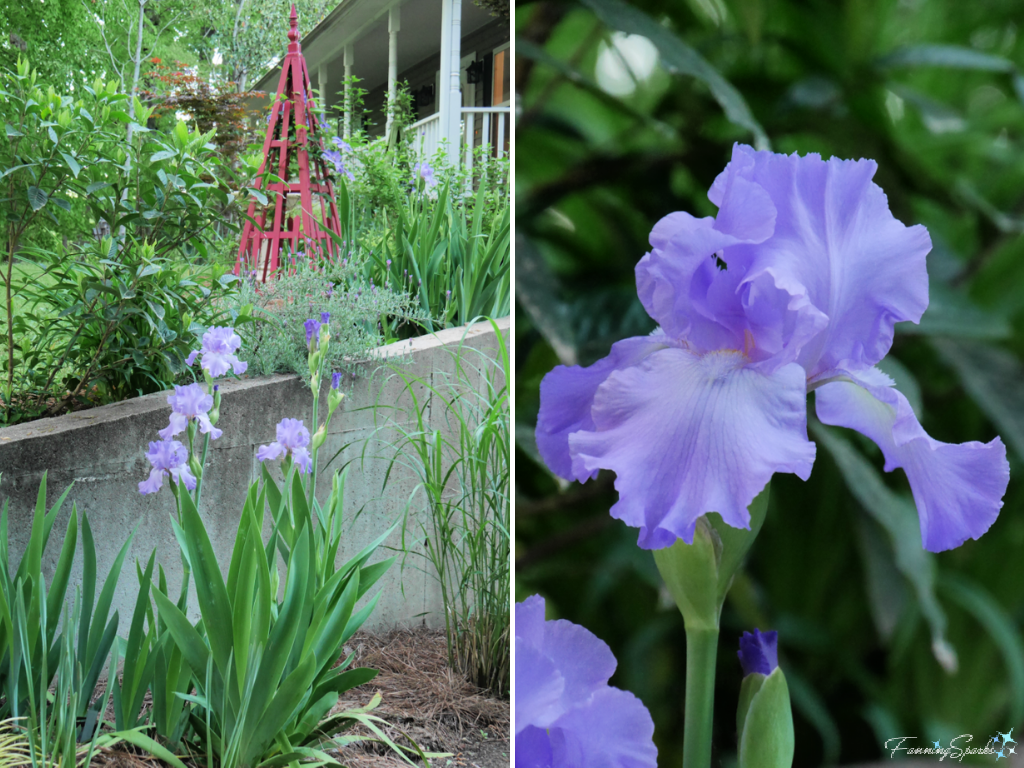
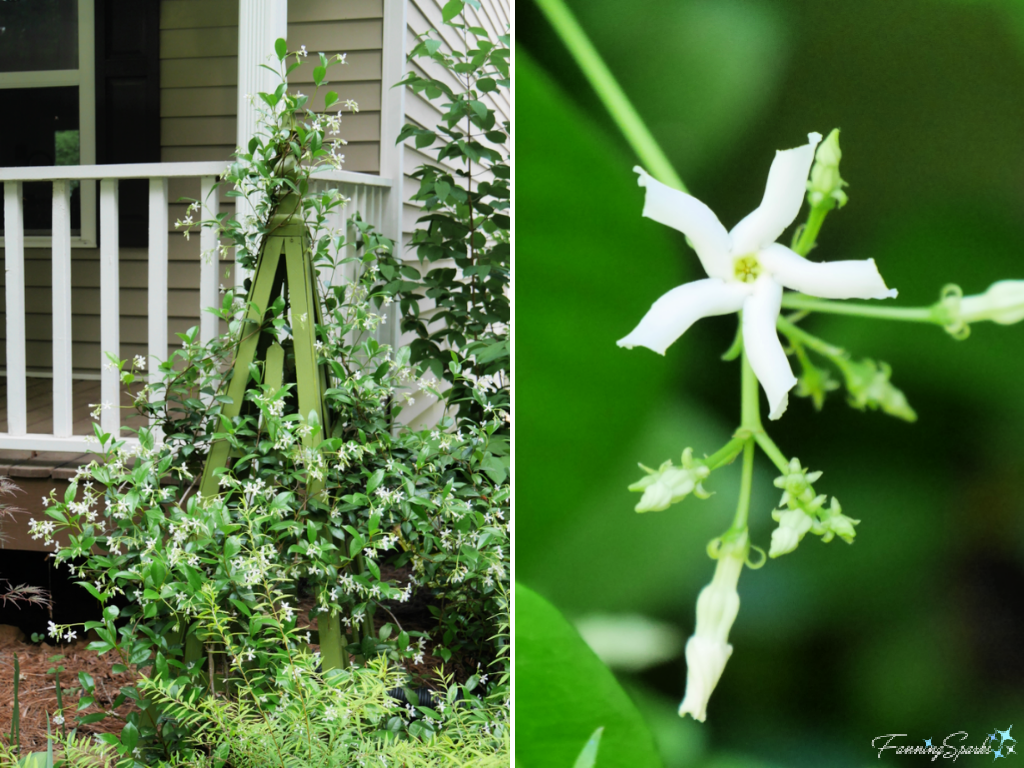 A couple more weeks and several of the hydrangeas bloomed for the first time. Pictured are a Oakleaf Hydrangea (Hydrangea quercifola ‘Snowflake’) and a Big Leaf Hydrangea ‘Endless Summer’ (Hydrangea macrophylla ‘Endless Summer’).
A couple more weeks and several of the hydrangeas bloomed for the first time. Pictured are a Oakleaf Hydrangea (Hydrangea quercifola ‘Snowflake’) and a Big Leaf Hydrangea ‘Endless Summer’ (Hydrangea macrophylla ‘Endless Summer’).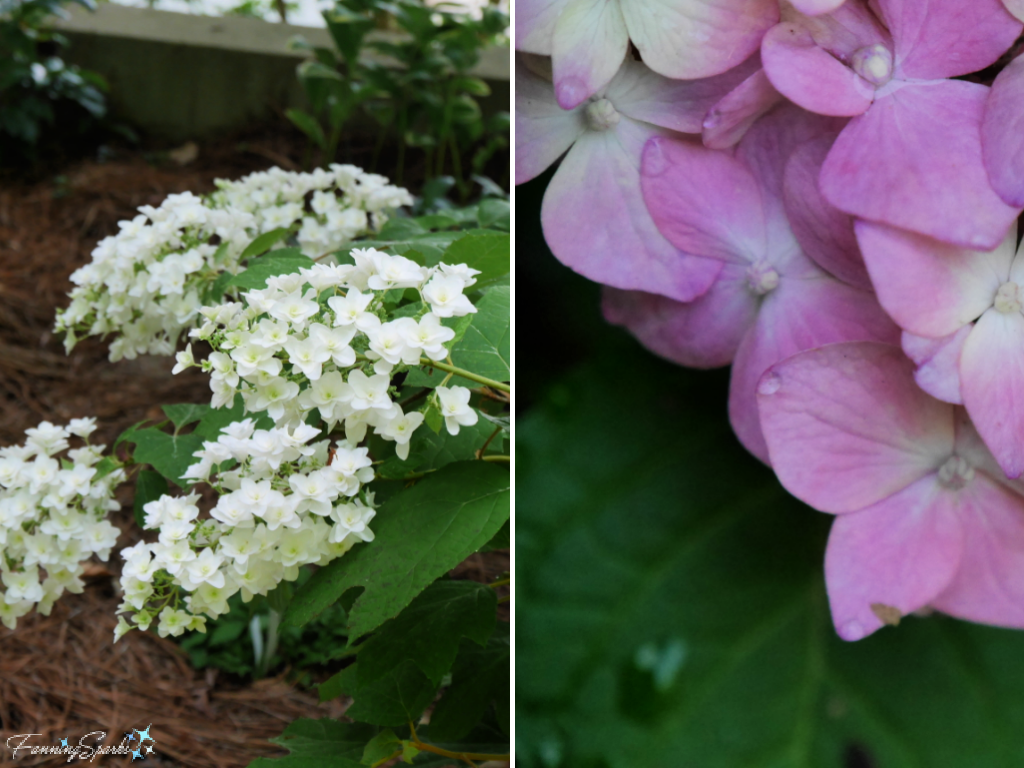 The floral show was outstanding but flowers don’t last long. The trick is to stretch it out by selecting plants with different blooming times. Another option is to include a variety of foliage with different plant forms, leaf shapes, patterns and colors.
The floral show was outstanding but flowers don’t last long. The trick is to stretch it out by selecting plants with different blooming times. Another option is to include a variety of foliage with different plant forms, leaf shapes, patterns and colors. Another way to add interest and variety is to strategically place large, potted plants in the flower beds. I first noticed this technique during a Garden Tour (see the post
Another way to add interest and variety is to strategically place large, potted plants in the flower beds. I first noticed this technique during a Garden Tour (see the post 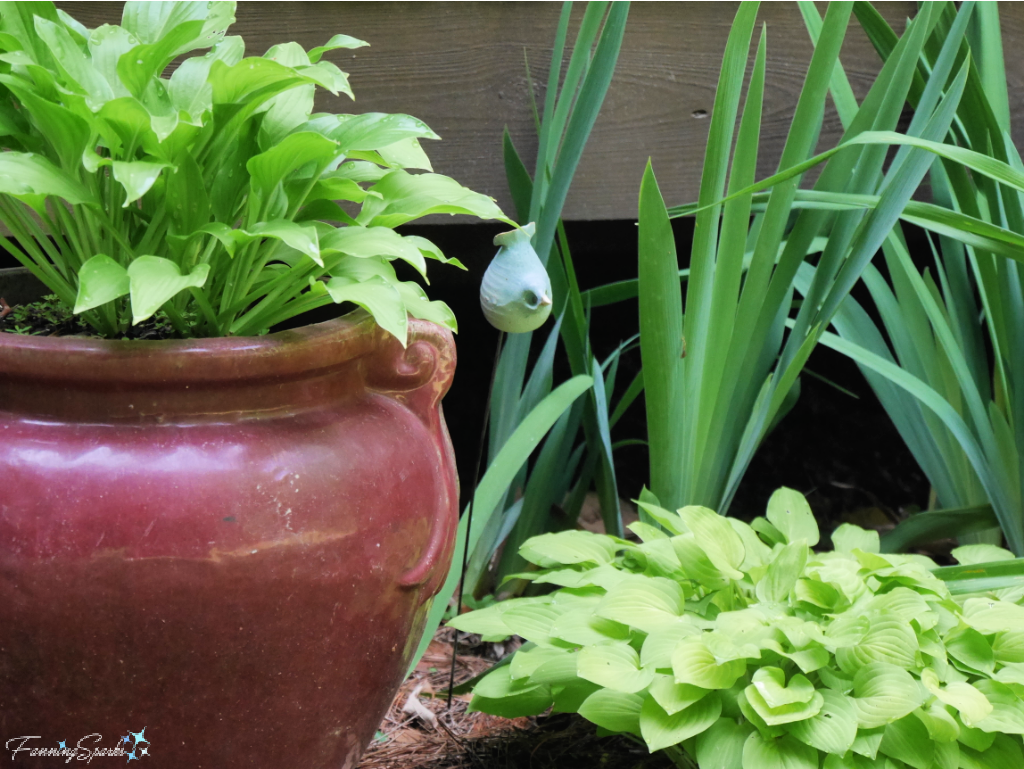 It’s fun to incorporate interesting elements into the garden. In the below section, for instance, I created a focal point with 3 rustic, turned-wood posts. The idea is to draw the eye across the garden to the far left side. I love to include salvaged, paint-chipped porch posts, balusters and newel posts in the garden. Admittedly, I’ve gathered quite a collection over the years and more than one mover has questioned why I would bother to move old wooden posts from one home to another!
It’s fun to incorporate interesting elements into the garden. In the below section, for instance, I created a focal point with 3 rustic, turned-wood posts. The idea is to draw the eye across the garden to the far left side. I love to include salvaged, paint-chipped porch posts, balusters and newel posts in the garden. Admittedly, I’ve gathered quite a collection over the years and more than one mover has questioned why I would bother to move old wooden posts from one home to another!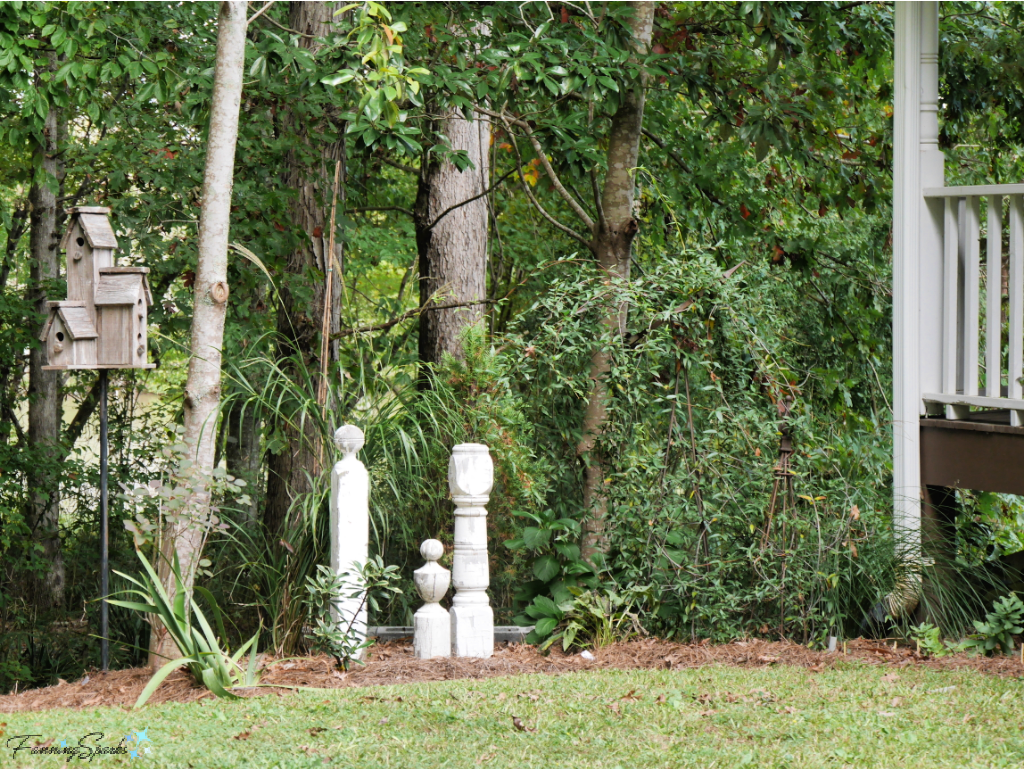 Strolling around the garden, especially in the early morning, is something I look forward to every day.
Strolling around the garden, especially in the early morning, is something I look forward to every day.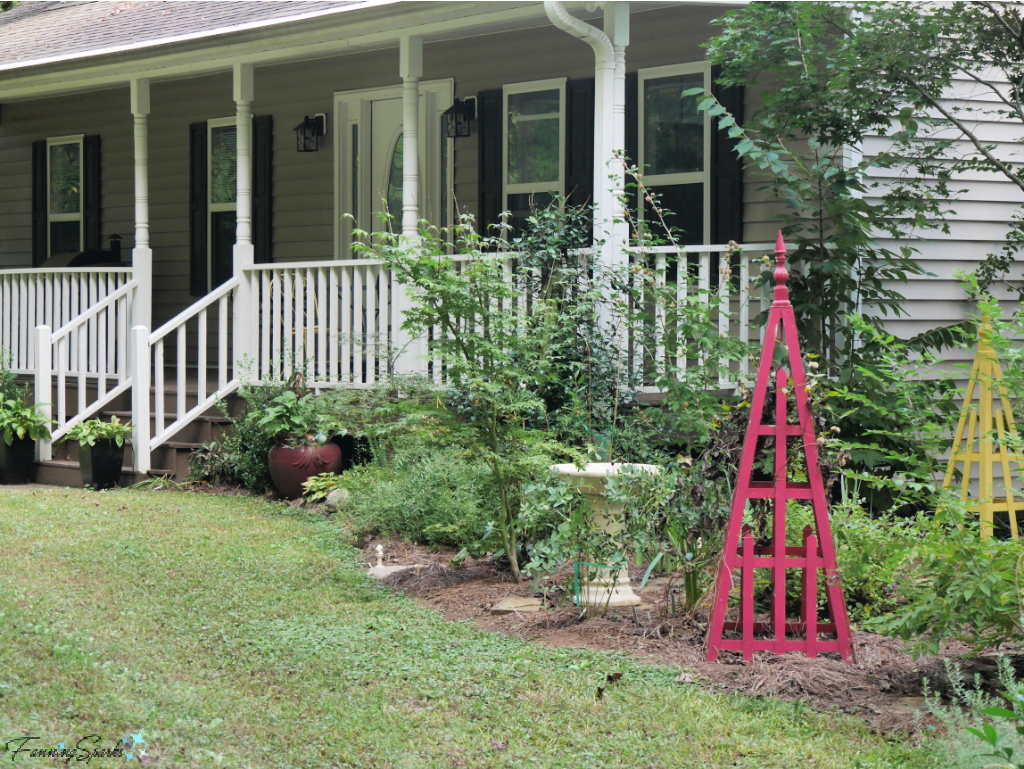
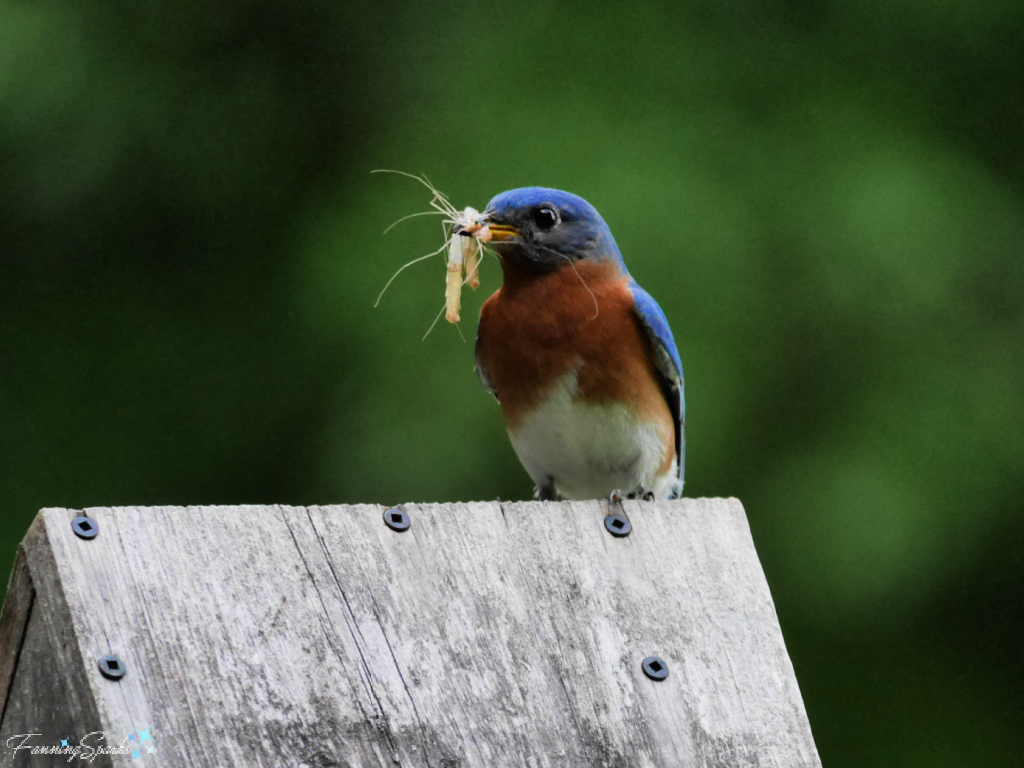 Here’s a beautiful male Eastern Bluebird sharing a perch with the metal bird on our bird bath.
Here’s a beautiful male Eastern Bluebird sharing a perch with the metal bird on our bird bath.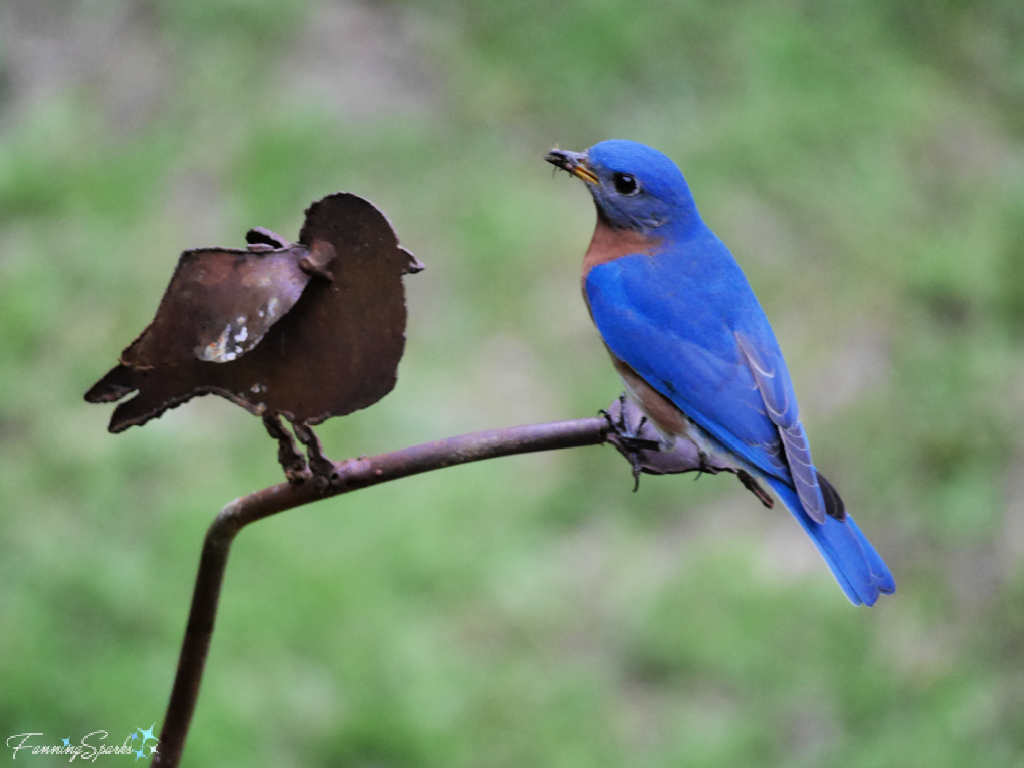 Meanwhile, a charming Prothonotary Warbler (Protonotaria citrea) built a nest in this rustic, condo-style birdhouse.
Meanwhile, a charming Prothonotary Warbler (Protonotaria citrea) built a nest in this rustic, condo-style birdhouse. Later in the summer, butterflies became frequent visitors (see post
Later in the summer, butterflies became frequent visitors (see post 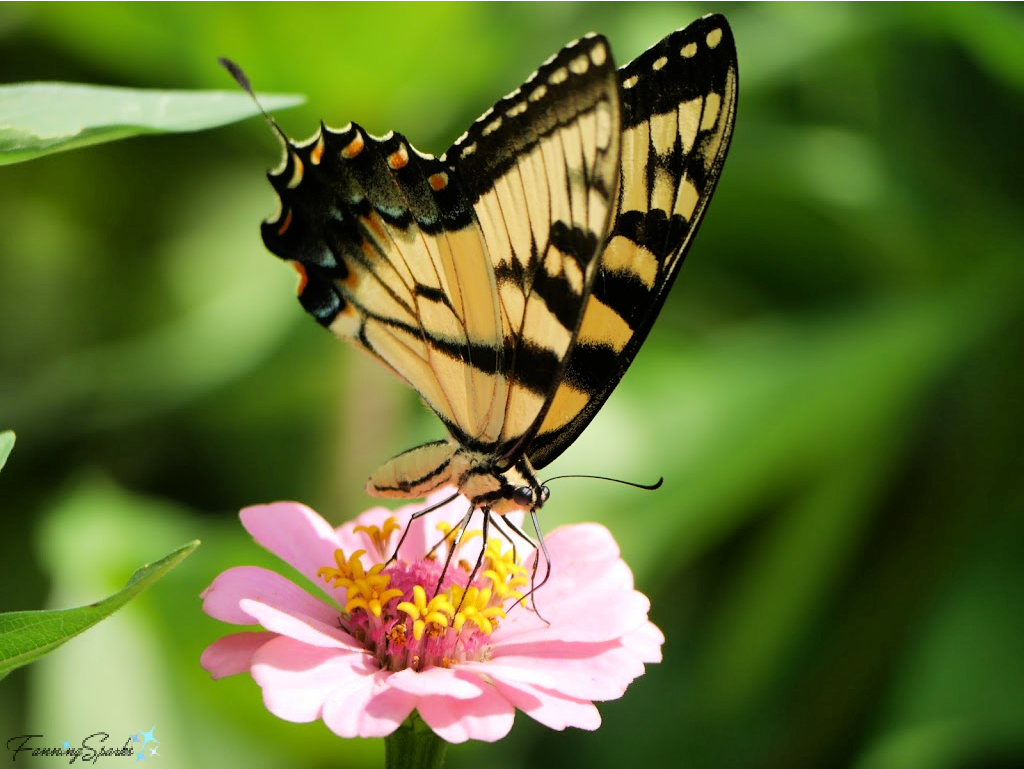 It’s now the beginning of November and the garden has slowed down. But there are still a few highlights to enjoy while I continue to tweak and refine. The Beautyberry (Callicarpa rubella), for instance, adds a jolt of unexpected color.
It’s now the beginning of November and the garden has slowed down. But there are still a few highlights to enjoy while I continue to tweak and refine. The Beautyberry (Callicarpa rubella), for instance, adds a jolt of unexpected color.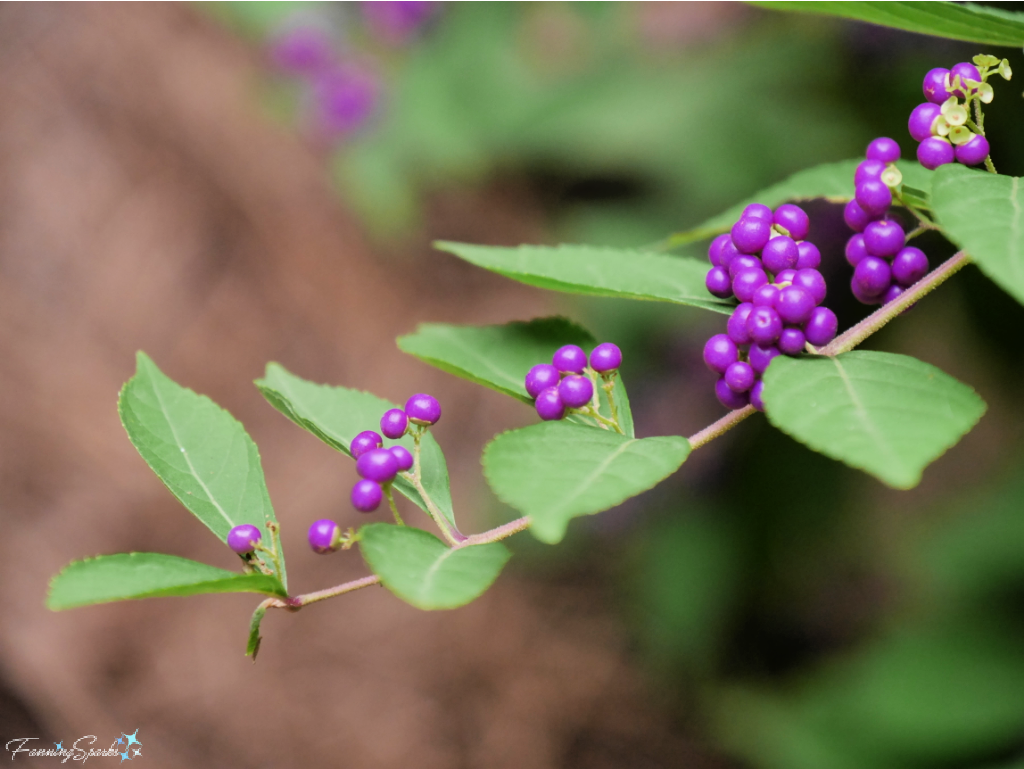 There’s nothing like before and after photos to illustrate progress. Our front garden has undergone quite a transformation in the first 2 years. I’m eager to see it leap into Year 3—something tells me I’d better get my pruning shears sharpened!
There’s nothing like before and after photos to illustrate progress. Our front garden has undergone quite a transformation in the first 2 years. I’m eager to see it leap into Year 3—something tells me I’d better get my pruning shears sharpened!